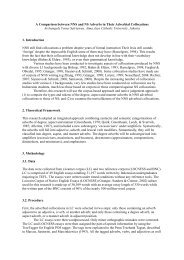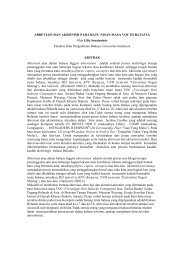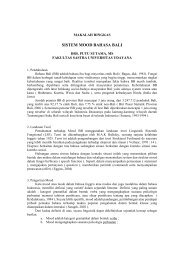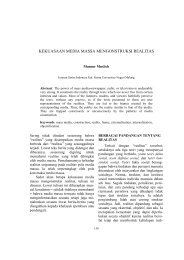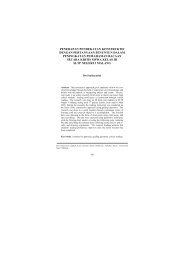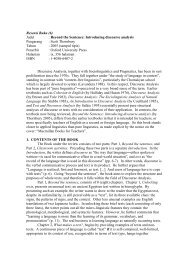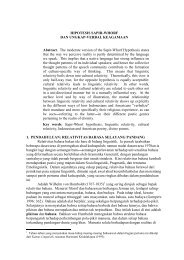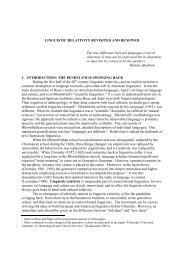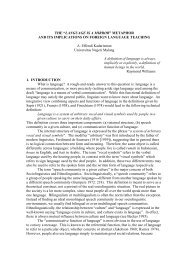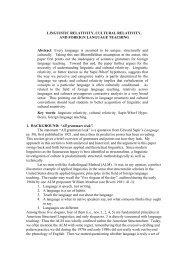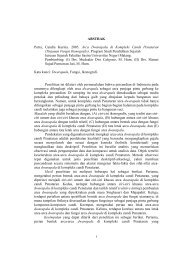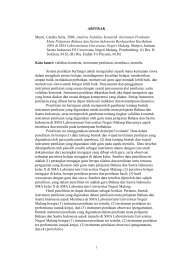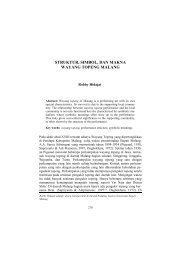the cooperative and politeness principles in radio broadcasting ...
the cooperative and politeness principles in radio broadcasting ...
the cooperative and politeness principles in radio broadcasting ...
You also want an ePaper? Increase the reach of your titles
YUMPU automatically turns print PDFs into web optimized ePapers that Google loves.
THE COOPERATIVE AND POLITENESS PRINCIPLES IN RADIO<br />
BROADCASTING CONVERSATIONS<br />
Suko W<strong>in</strong>arsih<br />
Universitas Kanjuruhan Malang<br />
Abstract: The present study aims at describ<strong>in</strong>g what exists <strong>in</strong> <strong>the</strong> <strong>in</strong>teractive<br />
telephone conversation program run by Radio MAS FM. The research subjects were<br />
<strong>the</strong> <strong>radio</strong> presenters, <strong>in</strong>vited guests, <strong>and</strong> audiences jo<strong>in</strong><strong>in</strong>g <strong>the</strong> program. The<br />
conversations were recorded us<strong>in</strong>g a tape recorder. The results of <strong>the</strong> data analysis<br />
show that generally <strong>the</strong> ten maxims of Cooperative Pr<strong>in</strong>ciple (CP) <strong>and</strong> Politeness<br />
Pr<strong>in</strong>ciple (PP) are applied by <strong>the</strong> subjects. However, conflictive function did not<br />
appear <strong>in</strong> <strong>the</strong> data.<br />
Key words: Cooperative Pr<strong>in</strong>ciple (CP), Politeness Pr<strong>in</strong>ciple (PP), Illocutionary<br />
Acts (IA), Conversations, Radio Broadcast<strong>in</strong>g Program<br />
Edmondson (1981:69) states that a verbal<br />
conversation refers to any <strong>in</strong>teractional talks<br />
<strong>in</strong>volv<strong>in</strong>g at least two participants, a speaker<br />
<strong>and</strong> a listener, <strong>and</strong> <strong>the</strong>y change roles. The<br />
conversation takes place <strong>in</strong> a non-formalized<br />
sett<strong>in</strong>g, with no special rules or<br />
conventions. This means that a verbal<br />
conversation requires at least two participants,<br />
<strong>the</strong> speaker <strong>and</strong> <strong>the</strong> listener.<br />
Besides, <strong>the</strong> participants converse about a<br />
certa<strong>in</strong> topic <strong>in</strong> a natural situation. In short,<br />
<strong>the</strong> study of conversation raises two aspects:<br />
<strong>the</strong> topic <strong>and</strong> <strong>the</strong> manner of <strong>the</strong><br />
conversation.<br />
A verbal conversation is a particular<br />
type of multiple-source spoken discourse.<br />
Edmondsond (1981:5) states <strong>the</strong>re are two<br />
k<strong>in</strong>ds of verbal conversation based on how<br />
<strong>the</strong> speaker <strong>and</strong> <strong>the</strong> listener are carry<strong>in</strong>g out<br />
<strong>the</strong> conversation. They are face-to-face<br />
verbal conversations <strong>and</strong> non face-to-face<br />
1<br />
verbal conversation.. The first refers to a<br />
conversation <strong>in</strong> which <strong>the</strong> participants, <strong>the</strong><br />
speaker <strong>and</strong> <strong>the</strong> listener, meet. In such a<br />
situation, <strong>in</strong>formation is also passed along<br />
through posture, h<strong>and</strong> gestures, k<strong>in</strong>esics,<br />
mimics, <strong>in</strong>tonation, etc. Moreover, <strong>the</strong><br />
speaker can quickly react to nonverbal<br />
reactions on <strong>the</strong> part of <strong>the</strong> listener. The<br />
second refers to a verbal conversation <strong>in</strong><br />
which <strong>the</strong> participants, namely <strong>the</strong> speaker<br />
<strong>and</strong> <strong>the</strong> listener do not meet <strong>in</strong> discuss<strong>in</strong>g a<br />
certa<strong>in</strong> topic directly but through certa<strong>in</strong><br />
equipments, for example by phone.<br />
This research concerns <strong>the</strong> second k<strong>in</strong>d<br />
of verbal conversation, namely <strong>the</strong> non<br />
face-to-face verbal conversations, specifically<br />
conversations over <strong>the</strong> telephone.<br />
Phone conversations are <strong>in</strong>terest<strong>in</strong>g to<br />
<strong>in</strong>vestigate s<strong>in</strong>ce <strong>the</strong>y happen without <strong>the</strong><br />
participants attendance <strong>in</strong> a certa<strong>in</strong> place or<br />
conversation location, so that <strong>the</strong> turn-
2 BAHASA DAN SENI, Tahun 37, Nomor 1, Februari 2009<br />
tak<strong>in</strong>g role is very important. Each participant<br />
should be patient <strong>in</strong> wait<strong>in</strong>g for an<br />
appropriate time to talk. Never<strong>the</strong>less, <strong>the</strong>re<br />
will be scrambled conversations, <strong>in</strong> which<br />
<strong>the</strong> participants talk toge<strong>the</strong>r at <strong>the</strong> same<br />
time. In addition, <strong>the</strong> participants <strong>in</strong> non<br />
face-to-face verbal conversations should<br />
cooperate with each o<strong>the</strong>r <strong>in</strong> <strong>the</strong>ir roles as<br />
<strong>the</strong> speaker <strong>and</strong> <strong>the</strong> listener or vice versa<br />
because <strong>the</strong> conversation goes on without<br />
<strong>the</strong> help of gestures, mimics, <strong>and</strong> k<strong>in</strong>esics.<br />
In summary, it is important to apply <strong>the</strong><br />
Cooperative <strong>and</strong> Politeness Pr<strong>in</strong>ciples <strong>in</strong><br />
conduct<strong>in</strong>g <strong>the</strong> non face-to-face verbal<br />
conversations, especially <strong>the</strong> conversations<br />
over <strong>the</strong> telephone.<br />
This research is a k<strong>in</strong>d of Pragmatics<br />
study. Pragmatics deals with <strong>the</strong> aspects of<br />
language structure <strong>and</strong> language <strong>pr<strong>in</strong>ciples</strong>.<br />
It studies <strong>the</strong> relation between language <strong>and</strong><br />
context that are encoded <strong>in</strong> <strong>the</strong> structure of<br />
language (Lev<strong>in</strong>son, 1983:9). A pragmaticist<br />
can analyze <strong>the</strong> discourse by means of<br />
implicature or conversational <strong>pr<strong>in</strong>ciples</strong> of<br />
<strong>the</strong> k<strong>in</strong>d illustrated by Grice s Cooperative<br />
Pr<strong>in</strong>ciple (CP <strong>and</strong> Leech s Politeness<br />
Pr<strong>in</strong>ciple (PP). Leech (1983:5) states that<br />
Pragmatics relates <strong>the</strong> sense of <strong>the</strong> utterance<br />
to its pragmatic force. This force may be<br />
relatively direct <strong>and</strong> <strong>in</strong>direct. In o<strong>the</strong>r<br />
words, <strong>the</strong> conversational implicature<br />
clarifies <strong>the</strong> dist<strong>in</strong>ction between literal<br />
mean<strong>in</strong>g <strong>and</strong> use of <strong>the</strong> utterance contextually.<br />
The maxims st<strong>and</strong> for a normative<br />
concept, like rule, norm, pr<strong>in</strong>ciple <strong>and</strong><br />
o<strong>the</strong>rs. The CP has four maxims: (1)<br />
quantity, (2) quality, (3) relation, <strong>and</strong> (4)<br />
manner. The PP has six maxims: (5) tact,<br />
(6) generosity, (7) approbation, (8) modesty,<br />
(9) agreement <strong>and</strong> (10) sympathy.<br />
The speakers purposes <strong>in</strong> <strong>the</strong>ir<br />
conversations conta<strong>in</strong> Illocutionary Acts<br />
(IA). Leech (1983:104) categorizes <strong>the</strong> IA<br />
based on <strong>the</strong> functions (1) competitive, (2)<br />
convivial, (3) collaborative <strong>and</strong> (4) conflictive.<br />
Edmondsond (1981:30) describes IA<br />
as utterances by means of which a speaker<br />
communicates his feel<strong>in</strong>gs, attitudes, belief,<br />
or <strong>in</strong>tention with respect to some events of<br />
state of affairs. In summary, illocutionary<br />
acts are performances or utterances of<br />
which a speaker communicates someth<strong>in</strong>g<br />
toward listeners as what <strong>the</strong> speaker expects<br />
of <strong>the</strong> utterances, which have some effect to<br />
<strong>the</strong> listeners.<br />
In <strong>the</strong> CP <strong>and</strong> PP, it is assumed that <strong>in</strong><br />
communicative events a speaker tries to<br />
communicate his needs, feel<strong>in</strong>gs, <strong>and</strong><br />
thoughts to his <strong>in</strong>terlocutors <strong>and</strong> expects<br />
<strong>the</strong>m to underst<strong>and</strong> his talk as easily as<br />
possi-ble. Hence, a speaker always tries to<br />
make his utterance easily comprehensible,<br />
relevant with <strong>the</strong> context, <strong>in</strong>dicat<strong>in</strong>g that he<br />
does not spend <strong>and</strong> waste a lot of time<br />
dur<strong>in</strong>g <strong>the</strong> conversation. There are some<br />
agreed guidel<strong>in</strong>es for talk or guid<strong>in</strong>g <strong>pr<strong>in</strong>ciples</strong><br />
or conversational maxims, which<br />
govern- <strong>cooperative</strong> talk. The listeners can<br />
catch <strong>the</strong> mean<strong>in</strong>g of <strong>the</strong> utterances only if<br />
<strong>the</strong> speakers <strong>and</strong> <strong>the</strong> listeners cooperate. To<br />
capture this notion, Grice (<strong>in</strong> Renkema,<br />
1993:10) proposes <strong>the</strong> CP. On <strong>the</strong> o<strong>the</strong>r<br />
h<strong>and</strong>, <strong>in</strong> conversations, <strong>politeness</strong> as<br />
proposed by Leech as <strong>the</strong> PP is also<br />
important.<br />
Those maxims of both CP <strong>and</strong> PP can<br />
be used to describe how participants <strong>in</strong><br />
conversations derive implicature. Discourse<br />
Analysis <strong>and</strong> Pragmatics concern <strong>the</strong> CP<br />
<strong>and</strong> PP referr<strong>in</strong>g to a description of how<br />
listeners get <strong>in</strong>formation from utterances<br />
even though <strong>the</strong> <strong>in</strong>formation has not been<br />
mentioned outright. It is <strong>in</strong>terest<strong>in</strong>g to<br />
<strong>in</strong>vestigate <strong>the</strong> CP <strong>and</strong> PP <strong>in</strong> <strong>the</strong> <strong>radio</strong><br />
broadcast<strong>in</strong>g conversations for <strong>the</strong> follow<strong>in</strong>g<br />
six reasons.<br />
Firstly, a verbal conversation is a k<strong>in</strong>d<br />
of talk most frequently <strong>and</strong> normally found<br />
<strong>in</strong> real life which covers many casual <strong>and</strong><br />
actual topics. Secondly, it is <strong>in</strong>terest<strong>in</strong>g to<br />
<strong>in</strong>vestigate ho <strong>the</strong> participants cooperate <strong>and</strong><br />
apply <strong>politeness</strong> as proposed by Grice <strong>and</strong><br />
Leech <strong>in</strong> carry<strong>in</strong>g out <strong>the</strong> conversations
over telephone on air <strong>in</strong> a <strong>radio</strong> broadcast<strong>in</strong>g<br />
program. Thirdly, be<strong>in</strong>g curious<br />
about <strong>the</strong> dynamics revealed <strong>in</strong> <strong>the</strong><br />
conversations about <strong>the</strong> topics, which are<br />
seem<strong>in</strong>gly casual, <strong>the</strong> researcher is<br />
<strong>in</strong>terested to <strong>in</strong>vestigate <strong>the</strong>m. Fourthly, it is<br />
very <strong>in</strong>terest<strong>in</strong>g to <strong>in</strong>vestigate: (1) how <strong>the</strong><br />
participants apply <strong>the</strong> CP <strong>and</strong> PP, (2)<br />
whe<strong>the</strong>r <strong>the</strong>y observe or violate <strong>the</strong> CP <strong>and</strong><br />
PP, (3) <strong>in</strong> what case <strong>and</strong> condition <strong>the</strong>y<br />
observe or violate <strong>the</strong> CP <strong>and</strong> PP <strong>in</strong> <strong>the</strong>ir<br />
conversations, <strong>and</strong> (4) what <strong>the</strong> reasons of<br />
observ<strong>in</strong>g <strong>and</strong> violat<strong>in</strong>g <strong>the</strong> CP <strong>and</strong> PP are.<br />
Fifthly, <strong>the</strong> conversations can be observed<br />
<strong>in</strong> terms of apply<strong>in</strong>g <strong>the</strong> CP <strong>and</strong> PP, as well<br />
as <strong>the</strong> IA. Sixthly, Radio Mas FM is chosen<br />
because it is <strong>the</strong> only <strong>radio</strong> station <strong>in</strong><br />
Malang, which conducts English conversations<br />
over <strong>the</strong> telephone for those who<br />
want to practice English through real<br />
English conversations.<br />
The verbal conversations over <strong>the</strong><br />
telephone <strong>in</strong> a <strong>radio</strong> program can be<br />
analyzed us<strong>in</strong>g <strong>the</strong> pragmatic approach<br />
s<strong>in</strong>ce pragmatics studies language use <strong>in</strong><br />
real life. Some pragmaticists give <strong>the</strong>ir<br />
def<strong>in</strong>ition of pragmatics <strong>in</strong> different terms<br />
but <strong>the</strong>y have <strong>the</strong> same concept, i.e. it<br />
concerns <strong>the</strong> way <strong>in</strong> which people use<br />
language <strong>in</strong> context. In o<strong>the</strong>r words, pragmatics<br />
deals with <strong>the</strong> mean<strong>in</strong>g of utterances<br />
produced by participants, speakers <strong>and</strong><br />
listeners, <strong>in</strong> a certa<strong>in</strong> contextual representation<br />
related to <strong>the</strong> general pr<strong>in</strong>ciple<br />
of <strong>the</strong> language use.<br />
The focus of <strong>in</strong>vestigation <strong>in</strong> this<br />
research is <strong>the</strong> CP <strong>and</strong> PP. The Cooperative<br />
Pr<strong>in</strong>ciples (CP) consists of four maxims<br />
(Grice <strong>in</strong> Brown <strong>and</strong> Yule, 1986:31):<br />
Quantity, Quality, Relation, <strong>and</strong> Manner.<br />
Leech (1983:132) mentions six maxims<br />
deal<strong>in</strong>g with <strong>the</strong> Politeness Pr<strong>in</strong>ciples (PP):<br />
Tact, Generosity, Approbation, Modesty,<br />
Agreement, <strong>and</strong> Sympathy. The reason for<br />
<strong>in</strong>vestigat<strong>in</strong>g <strong>the</strong> CP <strong>and</strong> PP is that it is not<br />
enough for us to underst<strong>and</strong> a conversation<br />
only from <strong>the</strong> side of pure l<strong>in</strong>guistics.<br />
W<strong>in</strong>arsih, The Cooperative <strong>and</strong> Politeness Pr<strong>in</strong>ciples 3<br />
Utterances do not only consist of phrases,<br />
clauses, or sentences. What <strong>in</strong>tentions<br />
beh<strong>in</strong>d <strong>the</strong>ir utterances are <strong>and</strong> how <strong>the</strong>y<br />
cooperate with each o<strong>the</strong>r <strong>in</strong> a conversation,<br />
so that <strong>the</strong> conversation proceeds successfully<br />
are <strong>the</strong> more important, <strong>in</strong>terest<strong>in</strong>g,<br />
<strong>and</strong> challeng<strong>in</strong>g ones.<br />
This study means to answer <strong>the</strong> general<br />
question: How is <strong>the</strong> CP <strong>and</strong> PP applied <strong>in</strong><br />
<strong>radio</strong> broadcast<strong>in</strong>g conversations? More<br />
specifically, <strong>the</strong> research problems fall <strong>in</strong>to<br />
<strong>the</strong> follow<strong>in</strong>g two questions: (1) to what<br />
extent are <strong>the</strong> CP <strong>and</strong> PP maxims applied <strong>in</strong><br />
<strong>the</strong> Mas FM <strong>radio</strong> broadcast<strong>in</strong>g conversations?<br />
And (2) what are <strong>the</strong> speakers<br />
purposes <strong>in</strong> apply<strong>in</strong>g <strong>the</strong> CP <strong>and</strong> PP maxims<br />
<strong>in</strong> <strong>the</strong>ir conversations <strong>in</strong> terms of<br />
illocutionary acts (IA)?<br />
In l<strong>in</strong>e with <strong>the</strong> research problems,<br />
<strong>the</strong> objective of <strong>the</strong> study is to describe <strong>the</strong><br />
use of CP <strong>in</strong> <strong>radio</strong> broadcast<strong>in</strong>g conversations.<br />
Particularly, <strong>the</strong> study aims at<br />
describ<strong>in</strong>g (1) <strong>the</strong> extent of <strong>the</strong> CP <strong>and</strong> PP<br />
maxims applied <strong>in</strong> <strong>the</strong> Mas FM <strong>radio</strong><br />
broadcast<strong>in</strong>g conversations, <strong>and</strong> (2) <strong>the</strong><br />
speakers purposes <strong>in</strong> apply<strong>in</strong>g <strong>the</strong> CP <strong>and</strong><br />
PP maxims <strong>in</strong> <strong>the</strong>ir conversations <strong>in</strong> terms<br />
of Illocutionary Acts (IA).<br />
METHOD<br />
Research Design. The study belongs to<br />
a qualitative design. The study is <strong>in</strong><br />
accordance with <strong>the</strong> descriptive qualitative<br />
<strong>and</strong> case study design based on several<br />
reasons. Firstly, <strong>the</strong> characteristic of <strong>the</strong><br />
descriptive qualitative research design is<br />
shown at <strong>the</strong> purpose of <strong>the</strong> study <strong>in</strong><br />
describ<strong>in</strong>g <strong>the</strong> observance of <strong>the</strong> CP <strong>and</strong> PP,<br />
<strong>the</strong> violation of <strong>the</strong> CP <strong>and</strong> PP, <strong>and</strong> <strong>the</strong><br />
reasons of apply<strong>in</strong>g <strong>the</strong>m. Secondly, <strong>the</strong><br />
characteristic of <strong>the</strong> qualitative study is<br />
<strong>in</strong>dicated by <strong>the</strong> pr<strong>in</strong>ciple methods <strong>and</strong> <strong>the</strong><br />
results of <strong>the</strong> study, which focuses on <strong>the</strong><br />
process ra<strong>the</strong>r than <strong>the</strong> product. Besides, it<br />
focuses on description or words ra<strong>the</strong>r than<br />
on numbers. Lastly, <strong>the</strong> study focuses on
4 BAHASA DAN SENI, Tahun 37, Nomor 1, Februari 2009<br />
data <strong>in</strong>terpretation based on <strong>the</strong> research<br />
problems <strong>and</strong> concentrates on <strong>the</strong> recorded<br />
spoken discourse <strong>in</strong> terms of dialogues<br />
among <strong>the</strong> participants.<br />
Data <strong>and</strong> Source of Data. Data <strong>in</strong> this<br />
research are <strong>the</strong> utterances produced by <strong>the</strong><br />
participants <strong>in</strong> <strong>the</strong> English conversations<br />
program at Mas FM <strong>radio</strong> broadcast The<br />
sources of data are <strong>the</strong> presenters, <strong>the</strong><br />
<strong>in</strong>vited quests <strong>and</strong> <strong>the</strong> audience when <strong>the</strong>y<br />
are discuss<strong>in</strong>g certa<strong>in</strong> topics forwarded on<br />
air. The participants to be <strong>the</strong> data sources<br />
of <strong>the</strong> study vary, for example <strong>the</strong>y are<br />
English department students <strong>in</strong> some<br />
universities at Malang, senior high school<br />
students at Malang, English teachers or<br />
lecturers, bank clerks, civil clerks,<br />
employees, house wives, etc who most of<br />
<strong>the</strong>m are not English native speakers.<br />
Instrument. The key <strong>in</strong>strument is <strong>the</strong><br />
researcher herself s<strong>in</strong>ce she observes <strong>the</strong><br />
relationship between <strong>the</strong> subjects, learns <strong>the</strong><br />
prelim<strong>in</strong>ary study, obta<strong>in</strong>s <strong>the</strong> data <strong>and</strong><br />
analyzes <strong>the</strong>m. Moreover, <strong>the</strong> researcher<br />
<strong>in</strong>terprets <strong>the</strong> observance <strong>and</strong> <strong>the</strong> violation<br />
of <strong>the</strong> CP <strong>and</strong> PP, <strong>and</strong> <strong>the</strong> purposes of<br />
apply<strong>in</strong>g <strong>the</strong>m based on her experiences <strong>and</strong><br />
background knowledge. She is supported by<br />
o<strong>the</strong>r <strong>in</strong>struments for perform<strong>in</strong>g <strong>the</strong><br />
behaviors <strong>and</strong> attributes to be studied. They<br />
are a <strong>radio</strong>, a tape recorder <strong>and</strong> some<br />
cassette recorders.<br />
Data Collection. The data are obta<strong>in</strong>ed<br />
by record<strong>in</strong>g <strong>the</strong> conversations over telephone<br />
at Mas FM <strong>radio</strong> broadcast. The<br />
researcher collects <strong>the</strong> data taken from Mas<br />
FM <strong>radio</strong> broadcast, which has English<br />
conversations program from Monday up to<br />
Friday at 7.00 up to 8.00 p.m. Before<br />
com<strong>in</strong>g to <strong>the</strong> record<strong>in</strong>g phase, <strong>the</strong> schedule<br />
of <strong>the</strong> record<strong>in</strong>g is determ<strong>in</strong>ed. In gett<strong>in</strong>g<br />
enough data for <strong>the</strong> research analyses, <strong>the</strong><br />
data collection phase is conducted four<br />
times <strong>in</strong> four days, divided <strong>in</strong>to four<br />
different topics. The duration of each topic<br />
discussed more or less an hour. To collect<br />
<strong>the</strong> data <strong>the</strong> researcher does two steps: (1)<br />
record<strong>in</strong>g <strong>the</strong> conversation conducted <strong>in</strong> <strong>the</strong><br />
Radio Mas FM, <strong>and</strong> (3) transcrib<strong>in</strong>g <strong>the</strong><br />
utterances produced by all presenters,<br />
<strong>in</strong>vited quests <strong>and</strong> audience as <strong>the</strong><br />
participants of <strong>the</strong> English conversations<br />
over <strong>the</strong> telephone <strong>in</strong> <strong>the</strong> Radio Mas FM.<br />
The transcription is divided <strong>in</strong>to four parts<br />
based on <strong>the</strong> days <strong>and</strong> topics <strong>the</strong>y discuss.<br />
Data Analysis. Data analysis consists of<br />
data transcription, data reduction, data<br />
display, <strong>and</strong> draw<strong>in</strong>g conclusion. Along<br />
with <strong>the</strong> data collection, <strong>the</strong> researcher<br />
transcribes all of <strong>the</strong> utterances produced by<br />
<strong>the</strong> participants as <strong>the</strong> subjects of <strong>the</strong> study.<br />
They are <strong>the</strong> <strong>radio</strong> presenters, <strong>the</strong> <strong>in</strong>vited<br />
quests <strong>and</strong> <strong>the</strong> audience. Data reduction<br />
aims at process<strong>in</strong>g <strong>the</strong> raw data <strong>in</strong> order to<br />
be analyzed. The process, as suggested by<br />
Miles <strong>and</strong> Huberman (1994) might be <strong>in</strong> <strong>the</strong><br />
form of select<strong>in</strong>g, simplify<strong>in</strong>g, focus<strong>in</strong>g,<br />
summariz<strong>in</strong>g, cod<strong>in</strong>g, sort<strong>in</strong>g, or even<br />
mak<strong>in</strong>g cluster of <strong>the</strong>mes. In terms of this<br />
study, data reduction refers to <strong>the</strong> process of<br />
cod<strong>in</strong>g <strong>the</strong> subjects names, transcrib<strong>in</strong>g <strong>the</strong><br />
recorded conversations, cluster<strong>in</strong>g <strong>the</strong><br />
utterances to determ<strong>in</strong>e <strong>the</strong> existence of <strong>the</strong><br />
topic choice, <strong>and</strong> sort<strong>in</strong>g <strong>the</strong> irrelevant data.<br />
In terms of apply<strong>in</strong>g <strong>the</strong> CP <strong>and</strong> PP, some<br />
<strong>in</strong>dicators are limited to <strong>the</strong> observance <strong>and</strong><br />
violation. It is shown <strong>in</strong> <strong>the</strong> Table 1.
W<strong>in</strong>arsih, The Cooperative <strong>and</strong> Politeness Pr<strong>in</strong>ciples 5<br />
Table 1: Indicators of <strong>the</strong> Maxims Observance <strong>and</strong> Violation of <strong>the</strong> CP <strong>and</strong> PP<br />
Pr<strong>in</strong>ciples Maxims Indicators<br />
Observance Violation<br />
CP Quantity 1. Not excessive<br />
1. Excessive<br />
2. Not repeated<br />
2. Repeated<br />
3. Informative (Adequate 3. Less <strong>in</strong>formative<br />
<strong>in</strong>formation)<br />
(Inadequate <strong>in</strong>formation)<br />
CP Quality Truthful (Supported by Untruthful (Unsupported<br />
adequate evidence) by adequate evidence)<br />
CP Relation Based on topic Out of topic<br />
s: speaker<br />
h: listener<br />
CP Manner 1. Perspicuous<br />
2. Brief<br />
3. Orderly<br />
PP Tact 1. M<strong>in</strong>imize cost to o<strong>the</strong>r<br />
(h)<br />
2. Maximize benefit to<br />
o<strong>the</strong>r (h)<br />
PP Generosity 1. M<strong>in</strong>imize benefit to self<br />
(s)<br />
PP Approbation<br />
2. Maximize cost to self (s)<br />
1. M<strong>in</strong>imize dispraise of<br />
o<strong>the</strong>r (h)<br />
2. Maximize praise of o<strong>the</strong>r<br />
(h)<br />
PP Modesty 1. M<strong>in</strong>imize praise of self<br />
(s)<br />
2. Maximize dispraise of<br />
self (s)<br />
PP Agreement 1. M<strong>in</strong>imize disagreement<br />
between self (s) <strong>and</strong> o<strong>the</strong>r<br />
(h)<br />
2. Maximize agreement<br />
between self (s) <strong>and</strong> o<strong>the</strong>r<br />
(h)<br />
PP Sympathy 1. M<strong>in</strong>imize antipathy<br />
between self (s) <strong>and</strong> o<strong>the</strong>r<br />
(h)<br />
2. Maximize sympathy<br />
between self (s) <strong>and</strong> o<strong>the</strong>r<br />
(h)<br />
Data display, as suggested by Miles<br />
<strong>and</strong> Huberman (1994) is <strong>the</strong> process of<br />
demonstrat<strong>in</strong>g <strong>the</strong> data ei<strong>the</strong>r <strong>in</strong> <strong>the</strong> forms of<br />
narrative spoken texts, matrices, graphs,<br />
1. Ambiguous<br />
2. Prolix<br />
3. Disorderly<br />
1. Maximize cost to o<strong>the</strong>r<br />
(h)<br />
2. M<strong>in</strong>imize benefit to<br />
o<strong>the</strong>r (h)<br />
1. Maximize benefit to self<br />
(s)<br />
2. M<strong>in</strong>imize cost to self (s)<br />
1. Maximize dispraise of<br />
o<strong>the</strong>r (h)<br />
2. M<strong>in</strong>imize praise of o<strong>the</strong>r<br />
(h)<br />
1. Maximize praise of self<br />
(s)<br />
2. M<strong>in</strong>imize dispraise of<br />
self (s)<br />
1. Maximize disagreement<br />
between self (s) <strong>and</strong> o<strong>the</strong>r<br />
(h)<br />
2. M<strong>in</strong>imize agreement<br />
between self (s) <strong>and</strong> o<strong>the</strong>r<br />
(h)<br />
1. Maximize antipathy<br />
between self (s) <strong>and</strong> o<strong>the</strong>r<br />
(h)<br />
2. M<strong>in</strong>imize sympathy<br />
between self (s) <strong>and</strong> o<strong>the</strong>r<br />
(h)<br />
network, <strong>and</strong> charts. The displayed data are<br />
expected to <strong>the</strong> completely underst<strong>and</strong><strong>in</strong>g <strong>in</strong><br />
<strong>the</strong> field <strong>and</strong> conclusion. In this study, <strong>the</strong>
6 BAHASA DAN SENI, Tahun 37, Nomor 1, Februari 2009<br />
data are displayed <strong>in</strong> <strong>the</strong> forms of<br />
conversations excerpts.<br />
Triangulation. The current study<br />
applies triangulation to check trustworth<strong>in</strong>ess<br />
of <strong>the</strong> results of data analysis. It<br />
aims at avoid<strong>in</strong>g <strong>the</strong> researcher s op<strong>in</strong>ion<br />
<strong>and</strong> biases. Three k<strong>in</strong>ds of triangulation are<br />
data triangulation, methodological triangulation,<br />
<strong>and</strong> <strong>the</strong>oretical triangulation.<br />
Data riangulation is a process, <strong>in</strong> which<br />
various sources of data are collected. The<br />
variety of sources can refer to time, space,<br />
<strong>and</strong> person (Denz<strong>in</strong>, 1978). The validity of<br />
<strong>the</strong> data is consulted by <strong>the</strong> one of <strong>the</strong><br />
Pragmatics experts: <strong>the</strong> researcher s advisor<br />
I. Methodological triangulation is a process,<br />
<strong>in</strong> which various methods are used to<br />
measure <strong>the</strong> same unit (Denz<strong>in</strong>, 1978). This<br />
type of triangulation uses ei<strong>the</strong>r <strong>the</strong> same<br />
method on different occasion or <strong>the</strong><br />
different methods on <strong>the</strong> same object of<br />
study. Triangulation is done by employ<strong>in</strong>g<br />
different methods of collect<strong>in</strong>g data. The<br />
method used <strong>in</strong> this research is taperecord<strong>in</strong>g.<br />
FINDINGS<br />
The research f<strong>in</strong>d<strong>in</strong>gs answer of <strong>the</strong> two<br />
research problems. First, <strong>the</strong> data classification<br />
as to <strong>the</strong>ir implicatures, maxims <strong>and</strong><br />
purposes conta<strong>in</strong>: (1) <strong>the</strong> implicature of<br />
every utterance, (2) four maxims of <strong>the</strong> CP<br />
<strong>and</strong> six maxims of <strong>the</strong> PP proposed by<br />
Grice <strong>and</strong> Leech, <strong>in</strong>clud<strong>in</strong>g: quantity,<br />
quality, relation, manner, tact, generosi-ty,<br />
approbation, modesty, agreement, sympathy,<br />
<strong>and</strong> (3) <strong>the</strong> speakers purposes <strong>in</strong><br />
terms of IA proposed by Leech s, <strong>in</strong>clud<strong>in</strong>g:<br />
Competitive, Convivial, Collaborative,<br />
Conflictive. Second, data frequency of<br />
occurrences deals with: (1) <strong>the</strong> numbers of<br />
utterances <strong>in</strong> every maxim <strong>in</strong> observance<br />
<strong>and</strong> violation, (2) <strong>the</strong> over-lapp<strong>in</strong>g utterances<br />
<strong>in</strong> <strong>the</strong> extent of apply<strong>in</strong>g <strong>the</strong> CP <strong>and</strong> PP<br />
maxims <strong>and</strong> (3) <strong>the</strong> speaker s purpose <strong>in</strong><br />
terms of IA.<br />
Data Classification as to Their<br />
Implicatures, Maxims, <strong>and</strong> Speakers<br />
Purposes (Illocutionary Acts)<br />
The data classification as to <strong>the</strong>ir<br />
implicatures, maxims <strong>and</strong> speakers s purposes<br />
<strong>in</strong> terms of illocutionary acts (IA) is a<br />
k<strong>in</strong>d of data analysis based on <strong>the</strong> utterances<br />
<strong>in</strong> <strong>the</strong> English conversation among <strong>the</strong><br />
participants <strong>in</strong> <strong>the</strong> MAS FM <strong>radio</strong> broadcast.<br />
They are <strong>the</strong> presenters, <strong>the</strong> <strong>radio</strong><br />
conversation (<strong>in</strong>vited) guests <strong>and</strong> <strong>the</strong> audiences.<br />
The utterances are recorded, transcribed,<br />
reduced, coded, <strong>in</strong>terpreted, <strong>and</strong> analyzed<br />
based on <strong>the</strong> CP <strong>and</strong> PP maxims <strong>and</strong><br />
<strong>the</strong> speakers s purposes <strong>in</strong> terms of <strong>the</strong> IA.<br />
Data Frequency of Occurrences<br />
This section describes three parts<br />
related to <strong>the</strong> data frequency of occurrences;<br />
<strong>the</strong>y are: (1) <strong>the</strong> extent of apply<strong>in</strong>g <strong>the</strong> CP<br />
<strong>and</strong> PP maxims, (2) <strong>the</strong> utterances with<br />
overlapp<strong>in</strong>g maxims, <strong>and</strong> (3) <strong>the</strong> speakers<br />
purposes <strong>in</strong> terms of illocutionary acts (IA).<br />
The Extent of Apply<strong>in</strong>g <strong>the</strong> CP <strong>and</strong> PP<br />
Maxims<br />
The research f<strong>in</strong>d<strong>in</strong>gs show that <strong>the</strong> ten<br />
maxims of <strong>the</strong> CP <strong>and</strong> PP are applied by <strong>the</strong><br />
participants <strong>in</strong> <strong>the</strong> conversations <strong>in</strong> terms of<br />
observance <strong>and</strong> violation.<br />
From 598 data analyzed, <strong>the</strong> most<br />
frequently observance maxims applied by<br />
<strong>the</strong> participants <strong>in</strong> MAS FM <strong>radio</strong> broadcast<strong>in</strong>g<br />
conversations are: Quantity, Relation,<br />
Manner, Quality, <strong>and</strong> Sympathy. It<br />
means that <strong>the</strong> most frequently applied by<br />
<strong>the</strong> participants is <strong>the</strong> CP. The f<strong>in</strong>d<strong>in</strong>gs<br />
show 466 (77.93%) utterances observ<strong>in</strong>g of<br />
Quantity Maxim, 449 (75.08%) utterances<br />
observ<strong>in</strong>g of Relation Maxim, 325 (54.35%)<br />
utterances observ<strong>in</strong>g of Manner Maxim,<br />
182 (30.43%) utterances observ<strong>in</strong>g of <strong>the</strong><br />
Quality Maxim, <strong>and</strong> 122 (20.40%) utterances<br />
observ<strong>in</strong>g Sympathy Maxim. On <strong>the</strong><br />
o<strong>the</strong>r h<strong>and</strong>, <strong>the</strong> least frequently ob-servance<br />
maxims applied by <strong>the</strong> participants are 83<br />
(13.88%) utterances observ<strong>in</strong>g of Agreement<br />
Maxim, 48 (8.03%) utterances
observ<strong>in</strong>g of Approbation Maxim, 35<br />
(5.85%) utterances observ<strong>in</strong>g of Tact<br />
maxim, 18 (3.00%) utterances observ<strong>in</strong>g of<br />
Generosity Maxim, <strong>and</strong> 12 (2.01%)<br />
utterances observ<strong>in</strong>g of Modesty Maxim.<br />
W<strong>in</strong>arsih, The Cooperative <strong>and</strong> Politeness Pr<strong>in</strong>ciples 7<br />
Table 2a: The Extent of Apply<strong>in</strong>g <strong>the</strong> CP Maxims<br />
Those maxims, <strong>in</strong>clud<strong>in</strong>g <strong>in</strong> observance <strong>and</strong><br />
violation are shown <strong>in</strong> <strong>the</strong> Table 2a, 2b, 3a<br />
<strong>and</strong> 3b.<br />
NO MAXIM NUMBER PERCENTAGE<br />
1 2 3 4<br />
1 QUANTITY<br />
2 RELATION<br />
3 MANNER<br />
= Observance<br />
X = Violation<br />
= Number<br />
= 342 73.39%<br />
X = 124 25.61%<br />
= 466<br />
= 292 65.03%<br />
X = 157 34.96%<br />
= 449<br />
= 233 71.59%<br />
X = 92<br />
= 325<br />
Table 2b: The Examples of Apply<strong>in</strong>g <strong>the</strong> CP Maxims<br />
NO MAXIM OBSERVANCE VIOLATION<br />
1 2 3 4<br />
1 QUANTITY Bless The Lord. It s a good<br />
wea<strong>the</strong>r today. I have no ra<strong>in</strong>.<br />
This is k<strong>in</strong>d to me. (VC34)<br />
2 RELATION I th<strong>in</strong>k, I have a phobia k<strong>in</strong>d<br />
of cockroach. (RD9)<br />
3 MANNER Yes, this is on air. So, we are<br />
talk<strong>in</strong>g about love betrayal,<br />
actually.<br />
(VC2)<br />
4 QUALITY Well, I feel exhausted<br />
actually today for many<br />
activities because my friends<br />
<strong>and</strong> me get any k<strong>in</strong>d of<br />
<strong>in</strong>formation of fly<strong>in</strong>g ticket to<br />
every airl<strong>in</strong>es. (SR15)<br />
VC: V<strong>in</strong>cent RD: Rudi<br />
ER: Erik AD: Andi<br />
SR: Sri TN: Trisna<br />
D: IndraDewi<br />
Betrayal? Oh, what s that?<br />
(ER3)<br />
And, have you got a d<strong>in</strong>ner?<br />
(VC21)<br />
I hope you are not to be angry<br />
to me because I have some<br />
fried bugs <strong>and</strong> fried flies.<br />
(VC24)<br />
I ll try to kill her. (ER5)
8 BAHASA DAN SENI, Tahun 37, Nomor 1, Februari 2009<br />
Table 3a: The Extent of Apply<strong>in</strong>g <strong>the</strong> PP Maxims<br />
NO MAXIM NUMBER PERCENTAGE<br />
1 2 3 4<br />
1 SYMPATHY<br />
2 AGREEMENT<br />
3 APPROBATION<br />
4 TACT<br />
5 GENEROSITY<br />
6 MODESTY<br />
= Observance<br />
X = Violation<br />
= Number<br />
= 113 92.62%<br />
X = 9 7.38%<br />
= 122<br />
= 66 79.52%<br />
X = 17 20.48%<br />
= 83<br />
= 40 83.33%<br />
X = 8 16.67%<br />
= 48<br />
= 30 85.72%<br />
X = 5 14.28%<br />
= 35<br />
= 7 38.88%<br />
X = 11 61.12%<br />
= 18<br />
= 6 50%<br />
X = 6 50%<br />
= 12
W<strong>in</strong>arsih, The Cooperative <strong>and</strong> Politeness Pr<strong>in</strong>ciples 9<br />
Table 3b: The Examples of Apply<strong>in</strong>g <strong>the</strong> PP Maxims<br />
NO MAXIM OBSERVANCE VIOLATION<br />
1 2 3 4<br />
1 SYMPATHY Oh my dear Eka, how pity<br />
you are! It s like <strong>the</strong>re is no<br />
o<strong>the</strong>r man <strong>in</strong> <strong>the</strong> world.<br />
Well, it must be hard, you<br />
know. (SR11)<br />
2 AGREEMENT Ya, I agree with you.<br />
(TN10)<br />
3 APPROBATIO<br />
N<br />
Keep on crazy! Keep on<br />
crazy! Be crazy! I like <strong>the</strong><br />
way you are crazy. (ER30)<br />
4 TACT Yeah, right. You are a<br />
typical person to make<br />
people feel happy. (AD28)<br />
5 GENEROSITY Okay, congratulation. I<br />
should give <strong>the</strong> time for <strong>the</strong><br />
listeners. Nice talk<strong>in</strong>g to<br />
you. Please, take care.<br />
Thank you bye! (AD30)<br />
6 MODESTY No, actually just help<strong>in</strong>g a<br />
friend. (S No, actually just<br />
help<strong>in</strong>g a friend.<br />
(SR16)<br />
Because you are <strong>the</strong> expert.<br />
You have so many .many<br />
girls.<br />
(AD12)<br />
t s okay. I don t feel from<br />
your voice. I don t feel that<br />
you are nervous. I th<strong>in</strong>k that s<br />
no problem at all. (ID39)<br />
I hope you are not to be angry<br />
to me because I have some<br />
fried bugs <strong>and</strong> fried flies.<br />
(VC24)<br />
You must be out of your<br />
m<strong>in</strong>d! (AD18)<br />
I ll try to kill her. (ER5)<br />
It s not like that. It s it s.. I<br />
just want to have good news<br />
that We are not married, so<br />
common, what should I<br />
br<strong>in</strong>g? We just let be a friend,<br />
let be a bro<strong>the</strong>r or a sister. I m<br />
still lov<strong>in</strong>g you, you re still<br />
lov<strong>in</strong>g me. If I am married it<br />
can be different. (VC47)<br />
VC: V<strong>in</strong>cent RD: Rudi ID: IndraDewi<br />
ER: Erik AD: Andi<br />
SR: Sri TN: Trisna<br />
Utterances with Overlapp<strong>in</strong>g Maxims<br />
terms of observance <strong>and</strong> violation. The<br />
examples are <strong>in</strong> <strong>the</strong> Table 4.<br />
The research f<strong>in</strong>d<strong>in</strong>gs show <strong>the</strong>re are<br />
525 utterances apply<strong>in</strong>g several maxims <strong>in</strong>
10 BAHASA DAN SENI, Tahun 37, Nomor 1, Februari 2009<br />
NO<br />
Table 4: The Overlapp<strong>in</strong>g Utterances <strong>in</strong> <strong>the</strong> Extent of Apply<strong>in</strong>g <strong>the</strong> CP Maxims<br />
DATA Code MAXIMS<br />
Q<br />
N<br />
1 2 3 4 5 6 7 8 9 10 11 12 13<br />
1 Okay, congratulation. I<br />
should give <strong>the</strong> time<br />
for <strong>the</strong> o<strong>the</strong>r listeners.<br />
Nice talk<strong>in</strong>g to you.<br />
Please take care. Thank<br />
you bye!<br />
2 Okay, Aji thank you<br />
very much for shar<strong>in</strong>g<br />
your experience, which<br />
is really nice to know.<br />
3 I just wanna to kill <strong>the</strong><br />
time. Sometimes it s<br />
happy with this crazy.<br />
But it s okay, so<br />
anyway you have to<br />
giveeen me op<strong>in</strong>ion<br />
about that we have to<br />
th<strong>in</strong>k first th<strong>in</strong>k<br />
first.<br />
AD<br />
30<br />
ID<br />
147<br />
VC7<br />
9<br />
AD: Andi QN: Quantity GN: Generosity : Observance<br />
ID: Indra Dewi QL: Quality AP: Approbation X: Violation<br />
VC: V<strong>in</strong>cent RL: Relation MD: Modesty<br />
MN: Manner AG: Agreement<br />
TC: Tact SP: Sympathy<br />
Example no.1 (AD12) shows an overlap<br />
of six maxims, one maxim <strong>in</strong> observance<br />
(Relation) <strong>and</strong> five maxims <strong>in</strong> violation<br />
(Quantity, Quality, Tact, Approbation <strong>and</strong><br />
Sympathy). Example no. 2 (AD 30) shows<br />
an overlap of four maxims <strong>in</strong> observance:<br />
Quantity, Tact, Approbation, <strong>and</strong> Sympathy.<br />
In addition, utterance no.3 (ID147)<br />
shows an overlap of six maxims <strong>in</strong><br />
observance: Quantity, Relation, Tact,<br />
Approbation, Agreement, <strong>and</strong> Sympathy.<br />
Example no. 4 (VC79) shows an overlap of<br />
four maxims: Quantity, Relation, Generosity,<br />
<strong>and</strong> Modesty.<br />
X<br />
Q<br />
L<br />
R<br />
L<br />
X<br />
M<br />
N<br />
T<br />
C<br />
G<br />
N<br />
X<br />
A<br />
P<br />
M<br />
D<br />
X<br />
A<br />
G<br />
S<br />
P<br />
The Speakers Purposes <strong>in</strong> Terms of<br />
Illocutionary Acts<br />
Each utterance produced by <strong>the</strong><br />
participant <strong>in</strong> <strong>the</strong> conversation has a purpose.<br />
Pragmatically, this purpose relates to<br />
<strong>the</strong> illocutionary acts. Leech (1983: 104)<br />
categorizes four types of illocutionary acts<br />
based on its functions: Competitive, Convivial,<br />
Collaborative <strong>and</strong> Conflictive. In <strong>the</strong><br />
Competitive Function, <strong>the</strong> illocutionary goal<br />
competes with <strong>the</strong> social goals; e.g.<br />
order<strong>in</strong>g, ask<strong>in</strong>g, dem<strong>and</strong><strong>in</strong>g, <strong>and</strong> begg<strong>in</strong>g.<br />
In <strong>the</strong> Convivial Function, <strong>the</strong> illocutionary
goal co<strong>in</strong>cides with <strong>the</strong> social goal; e.g.<br />
offer<strong>in</strong>g, <strong>in</strong>vit<strong>in</strong>g, greet<strong>in</strong>g, thank<strong>in</strong>g, mak<strong>in</strong>g<br />
a joke, comment<strong>in</strong>g <strong>and</strong> congratulat<strong>in</strong>g.<br />
In <strong>the</strong> Collaborative Function, <strong>the</strong><br />
illocutionary goal makes <strong>in</strong>different to <strong>the</strong><br />
social goal; e.g. assert<strong>in</strong>g, <strong>in</strong>form<strong>in</strong>g, shar<strong>in</strong>g<br />
op<strong>in</strong>ions (ideas), announc<strong>in</strong>g, ask<strong>in</strong>g a<br />
question, <strong>and</strong> <strong>in</strong>struct<strong>in</strong>g. Then, <strong>in</strong> <strong>the</strong><br />
Conflictive Function, <strong>the</strong> illocutionary goal<br />
W<strong>in</strong>arsih, The Cooperative <strong>and</strong> Politeness Pr<strong>in</strong>ciples 11<br />
conflicts with <strong>the</strong> social goal, i.e. threaten<strong>in</strong>g,<br />
accus<strong>in</strong>g, curs<strong>in</strong>g, <strong>and</strong> reprim<strong>and</strong><strong>in</strong>g.<br />
The research f<strong>in</strong>d<strong>in</strong>gs show that<br />
Competitive, Convivial, Collaborative are<br />
applied by <strong>the</strong> participants. While <strong>the</strong><br />
Conflictive Function is not used at all by <strong>the</strong><br />
participant. The details are <strong>in</strong> <strong>the</strong> Table 4.<br />
Table 4a: The Speakers Purposes <strong>in</strong> Terms of Illocutionary Acts<br />
Illocutionary<br />
Acts (IA)<br />
Sub function of IA Numbers Percentage<br />
1 2 3 4<br />
Competitive Order<strong>in</strong>g 9 1.50%<br />
Ask<strong>in</strong>g 0<br />
Dem<strong>and</strong><strong>in</strong>g 9 1.50%<br />
Begg<strong>in</strong>g 0<br />
18 3.00%<br />
Convivial Invit<strong>in</strong>g 2 0.33%<br />
Greet<strong>in</strong>g 61 1.02%<br />
Thank<strong>in</strong>g 13 2.17%<br />
Mak<strong>in</strong>g a joke 40 6.69%<br />
Comment<strong>in</strong>g 43 7.19%<br />
Congratulat<strong>in</strong>g 0 0%<br />
172 28.76%<br />
Collaborative Assert<strong>in</strong>g 134 22.41%<br />
Inform<strong>in</strong>g 87 14.55%<br />
Shar<strong>in</strong>g op<strong>in</strong>ion 77 12.89%<br />
Ask<strong>in</strong>g a question 107 17.89%<br />
Announc<strong>in</strong>g 0 0%<br />
Instruct<strong>in</strong>g 3 0.50%<br />
408 68.24%<br />
Conflictive 0 0%<br />
598 100%
12 BAHASA DAN SENI, Tahun 37, Nomor 1, Februari 2009<br />
Table 4b: The Examples of <strong>the</strong> Speakers Purposes <strong>in</strong> Terms of Illocutionary Acts<br />
Illocutionary<br />
Acts (IA)<br />
Sub function of IA Examples<br />
1 2 3<br />
Competitive Order<strong>in</strong>g By <strong>the</strong> way, can you help me to correct my<br />
English. (ST3)<br />
Ask<strong>in</strong>g -<br />
Dem<strong>and</strong><strong>in</strong>g Aha, actually you should not br<strong>in</strong>g that on<br />
air. (AD11)<br />
Begg<strong>in</strong>g -<br />
Convivial Invit<strong>in</strong>g If you have some comments or questions to<br />
Aji, just go head.. or maybe you are one of<br />
<strong>the</strong>m. (ID89)<br />
Greet<strong>in</strong>g One th<strong>in</strong>g that maybe I can help you Dewa<br />
because Mas FM also has a community <strong>and</strong><br />
next Sunday <strong>the</strong>re will be a meet<strong>in</strong>g. So, I<br />
<strong>in</strong>vite you . jo<strong>in</strong> us. (ID101)<br />
Thank<strong>in</strong>g Hi, Erik! (TN4)<br />
Mak<strong>in</strong>g a joke Okay, Aji thank you very much for shar<strong>in</strong>g<br />
your expe-rience, which is really nice to<br />
know. (ID147)<br />
Comment<strong>in</strong>g Haa haaa Mr. Andi, yes, it s very<br />
Javanese person. Do you want to know his<br />
full name? It s perfect. Common tell me!<br />
Andi-<strong>and</strong>i Lumut, <strong>the</strong>re is <strong>the</strong> truth. (VC53)<br />
Congratulat<strong>in</strong>g Wow.. you have to master <strong>in</strong> English. No<br />
reason. (ID92)<br />
Of course, it is not <strong>the</strong>ir m<strong>in</strong>d, you know.<br />
They are not nor-mal person s, I th<strong>in</strong>k,. And<br />
<strong>the</strong>y should be <strong>in</strong> <strong>the</strong> national graphic<br />
channel animal. Yaa, like <strong>the</strong> animals. You<br />
know <strong>the</strong> movie that <strong>the</strong>y are not human<br />
be<strong>in</strong>gs. Animals like to kill <strong>the</strong>ir friends<br />
because <strong>the</strong>y want to attract ano<strong>the</strong>r..<br />
ano<strong>the</strong>r fe-male but likewise ano<strong>the</strong>r female,<br />
so, <strong>the</strong> national graphic. It s really out<br />
of <strong>the</strong> m<strong>in</strong>d, you know. (SR19)<br />
Collaborative Assert<strong>in</strong>g Mas FM at Jl. Dr. Cipto . Yaa .yaa<br />
number 16 at n<strong>in</strong>e. (ID102)<br />
Inform<strong>in</strong>g Ya, seven days before <strong>the</strong> hik<strong>in</strong>g our m<strong>in</strong>d<br />
should be clear. So, we have to do a little bit<br />
jogg<strong>in</strong>g, runn<strong>in</strong>g <strong>and</strong> try to make m<strong>in</strong>imum
Illocutionary<br />
Acts (IA)<br />
W<strong>in</strong>arsih, The Cooperative <strong>and</strong> Politeness Pr<strong>in</strong>ciples 13<br />
Sub function of IA Examples<br />
1 2 3<br />
depression. (AJ40)<br />
Shar<strong>in</strong>g op<strong>in</strong>ion So, what do you th<strong>in</strong>g about part time job<br />
for students? (TN9)<br />
Ask<strong>in</strong>g a question -<br />
Announc<strong>in</strong>g Oh yeah try to f<strong>in</strong>d ano<strong>the</strong>r man. (SR21)<br />
Instruct<strong>in</strong>g<br />
Conflictive -<br />
VC: V<strong>in</strong>cent RD: Rudi<br />
ER: Erik AD: Andi<br />
SR: Sri TN: Trisna<br />
ID: IndraDewi<br />
DISCUSSION<br />
This section deals with <strong>the</strong> discussion<br />
referr<strong>in</strong>g to <strong>the</strong> research f<strong>in</strong>d<strong>in</strong>gs based on<br />
<strong>the</strong> two research problems. The first is <strong>the</strong><br />
extent of <strong>the</strong> use of <strong>the</strong> CP <strong>and</strong> <strong>the</strong> PP <strong>in</strong> <strong>the</strong><br />
English <strong>radio</strong> broadcast<strong>in</strong>g conversations.<br />
The second is <strong>the</strong> speakers purposes <strong>in</strong><br />
apply<strong>in</strong>g <strong>the</strong> CP <strong>and</strong> <strong>the</strong> PP maxims <strong>in</strong> <strong>the</strong>ir<br />
conversations <strong>in</strong> terms of Illocutionary Acts<br />
(IA).<br />
The Extent of <strong>the</strong> Use of <strong>the</strong> CP <strong>and</strong> <strong>the</strong><br />
PP <strong>in</strong> <strong>the</strong> English Radio Broadcast<strong>in</strong>g<br />
Conversations<br />
First, <strong>the</strong> most frequently used maxims<br />
as applied by <strong>the</strong> participants, respectively<br />
<strong>in</strong> terms of <strong>the</strong> CP: Quantity, Relation,<br />
Manner, Quality, <strong>and</strong> one maxim of <strong>the</strong> PP:<br />
Sympathy.<br />
Leech (1983: 84) says that <strong>the</strong> Quantity<br />
<strong>and</strong> Quality Maxims can be considered<br />
toge-<strong>the</strong>r, s<strong>in</strong>ce <strong>the</strong>y frequently work <strong>in</strong><br />
competition with one ano<strong>the</strong>r; <strong>the</strong> amount<br />
of <strong>in</strong>formation s gives is limited by s s wish<br />
to avoid tell<strong>in</strong>g untruth. For this reason,<br />
Harnish (1976 <strong>in</strong> Leech, 1983:85) proposes<br />
a comb<strong>in</strong>ed maxims as Make <strong>the</strong> strongest<br />
relevant claim justifiable by your evidence.<br />
Fur<strong>the</strong>r, Leech (1983:85) expla<strong>in</strong>s that<br />
strength refers to <strong>the</strong> amount of <strong>in</strong>formation<br />
communicated. He adds, by way of<br />
Quantity-Quality Maxim a large number<br />
of <strong>in</strong>formal <strong>in</strong>ferences can be accounted for.<br />
The f<strong>in</strong>d<strong>in</strong>g that <strong>the</strong> participants<br />
observe <strong>the</strong> Quantity Maxim most<br />
frequently is quite acceptable s<strong>in</strong>ce <strong>the</strong><br />
media used <strong>in</strong> carry<strong>in</strong>g out <strong>the</strong>ir conversation<br />
is <strong>radio</strong> broadcast, <strong>in</strong> which <strong>the</strong>y have<br />
to manage <strong>the</strong> time wisely. Therefore, <strong>the</strong><br />
participants converse as is needed <strong>and</strong> as<br />
fur<strong>the</strong>r <strong>in</strong>formation based on a topic. This is<br />
related to <strong>the</strong> pr<strong>in</strong>ciple of <strong>the</strong> Quantity<br />
Maxim that utterances produced by <strong>the</strong><br />
speaker could not be more than he needs to<br />
say to <strong>the</strong> listener. It is related to <strong>the</strong><br />
<strong>in</strong>dicators of <strong>the</strong> maxim observance that <strong>the</strong><br />
utterances are: (1) not excessive, (2) not<br />
repeated, <strong>and</strong> (3) <strong>in</strong>formative (adequate<br />
<strong>in</strong>formation). While <strong>the</strong> maxim violation<br />
<strong>in</strong>dicates that, <strong>the</strong> utterances are: (1)<br />
excessive, (2) repeated, <strong>and</strong> (3) less<br />
<strong>in</strong>formative (<strong>in</strong>adequate <strong>in</strong>formation).<br />
The utterance produced by <strong>the</strong><br />
presenter, V<strong>in</strong>cent <strong>in</strong> <strong>the</strong> first topic Love<br />
Betrayal : Bless <strong>the</strong> Lord. It s good wea<strong>the</strong>r
14 BAHASA DAN SENI, Tahun 37, Nomor 1, Februari 2009<br />
today. I have no ra<strong>in</strong>. This is k<strong>in</strong>d to me<br />
(VC34) applies <strong>the</strong> Quantity Maxim. This<br />
utterance <strong>in</strong>dicates <strong>the</strong> observance criteria.<br />
In o<strong>the</strong>r words, this utterance is not<br />
excessive <strong>and</strong> <strong>in</strong>formative, especially <strong>the</strong><br />
<strong>in</strong>formation about <strong>the</strong> wea<strong>the</strong>r. On <strong>the</strong> o<strong>the</strong>r<br />
h<strong>and</strong>, <strong>the</strong> utterance produced by one of <strong>the</strong><br />
audience, Erik: Betrayal? Oh. What s that?<br />
(ER3) violates <strong>the</strong> maxim. Erik repeats what<br />
<strong>the</strong> presenter said. Besides, this utterance is<br />
excessive because what <strong>the</strong> presenter said,<br />
V<strong>in</strong>cent, is quite clear. However, Erik s<br />
repeated <strong>the</strong> word betrayal is acceptable<br />
because of two reasons. First, Erik is not<br />
familiar with <strong>the</strong> word, so he wants to make<br />
sure about <strong>the</strong> word uttered by <strong>the</strong><br />
presenter. Second, Erik is surprised about<br />
<strong>the</strong> topic discussed because he does not<br />
follow <strong>the</strong> program from <strong>the</strong> beg<strong>in</strong>n<strong>in</strong>g.<br />
When he wants to share his op<strong>in</strong>ion, he does<br />
not exactly know <strong>the</strong> topic discussed.<br />
Thus, <strong>the</strong> pr<strong>in</strong>ciple of Quality Maxim is<br />
that <strong>the</strong> utterances produced by <strong>the</strong> speaker<br />
conta<strong>in</strong> <strong>the</strong> truth. The <strong>in</strong>dicator of <strong>the</strong><br />
maxim s observance is truthful (supported<br />
by adequate evidence). On <strong>the</strong> o<strong>the</strong>r h<strong>and</strong>,<br />
<strong>the</strong> <strong>in</strong>dicator of <strong>the</strong> maxim violation is<br />
untruthful or unsupported by adequate<br />
evidence.<br />
Sri s utterance Well, I feel exhausted<br />
actually today for many active-ties because<br />
my friends <strong>and</strong> I get any k<strong>in</strong>d of <strong>in</strong>formation<br />
of fly<strong>in</strong>g ticket to every airl<strong>in</strong>e (SR15)<br />
fulfills of truthfulness. Sri tries to share her<br />
health condition that she is very tired. She<br />
expla<strong>in</strong>s why she is tired. Based on <strong>the</strong><br />
Quality Maxim pr<strong>in</strong>ciple, Sri s utterance is<br />
truthful <strong>and</strong> supported by adequate <strong>in</strong>formation.<br />
The second example is <strong>the</strong> violation<br />
maxim, such as Erik s utterance: I ll to` kill<br />
her (ER5). This utterance is untruthful.<br />
Actually, Erik wants to make a joke through<br />
his utterance because he disagrees with a<br />
girl, who betrays his partner.<br />
The Relation Maxim is also mostly used<br />
by <strong>the</strong> participants s<strong>in</strong>ce <strong>the</strong> utter-ances<br />
produced by <strong>the</strong> participants <strong>in</strong> Mas FM<br />
<strong>radio</strong> broadcast<strong>in</strong>g conversations are<br />
relevant to its situation. The participants<br />
discuss <strong>the</strong> topic forwarded. Most of <strong>the</strong>m<br />
uttered <strong>the</strong>ir ideas <strong>and</strong> op<strong>in</strong>ion about a<br />
topic. This is related to <strong>the</strong> Relation Maxim.<br />
The <strong>in</strong>dicator is that <strong>the</strong> utterance is on <strong>the</strong><br />
topic (relevant).<br />
Leech (1983:93) treats <strong>the</strong> Relation<br />
Maxim as a special k<strong>in</strong>d of <strong>in</strong>formation . It<br />
refers to a certa<strong>in</strong> topic discussed. Rudi s<br />
utterance: I th<strong>in</strong>k, I have a phobia k<strong>in</strong>d of<br />
cockroach (RD9) is relevant to <strong>the</strong> topic<br />
forwarded- Fear of Someth<strong>in</strong>g. Rudi, <strong>the</strong><br />
audience, has a certa<strong>in</strong> k<strong>in</strong>d of fear. He has<br />
a fear of cockroaches. In <strong>the</strong> next<br />
conversation, Rudi tells more <strong>and</strong> shares a<br />
lot of his experiences about why <strong>and</strong><br />
how he fears <strong>the</strong> <strong>in</strong>sect. Therefore, Rudi s<br />
utterance really <strong>in</strong>dicates <strong>the</strong> observance of<br />
<strong>the</strong> Relation Maxim. He tries to give a<br />
special k<strong>in</strong>d of <strong>in</strong>formation - fear of<br />
someth<strong>in</strong>g. On <strong>the</strong> o<strong>the</strong>r h<strong>and</strong>, <strong>the</strong> maxim<br />
violation appears <strong>in</strong> V<strong>in</strong>cent s utterance:<br />
And, have you got a d<strong>in</strong>ner? (VC21). As a<br />
presenter, he has to suggest <strong>the</strong> audience to<br />
discuss <strong>the</strong> topic<br />
Love Betrayal but he has<br />
not. However, actually it is accepted s<strong>in</strong>ce<br />
<strong>the</strong> way <strong>the</strong>y converse <strong>in</strong>dicates that <strong>the</strong>y<br />
are old friends. The audience often seems to<br />
participate <strong>in</strong> this English conversation<br />
program <strong>in</strong> Mas FM. He is not a newcomer.<br />
He knows V<strong>in</strong>cent, <strong>the</strong> presenter, so that <strong>the</strong><br />
conversation goes freely, conta<strong>in</strong><strong>in</strong>g several<br />
jokes, <strong>and</strong> even out of <strong>the</strong> topic. However,<br />
f<strong>in</strong>ally <strong>the</strong>y return to <strong>the</strong> topic forwarded.<br />
So far, Leech (1983; 94) acknowledges<br />
that <strong>the</strong> relevance of one utterance to<br />
ano<strong>the</strong>r is as part of a broader conception of<br />
relevance, <strong>the</strong> relevance of an utterance to<br />
its speech situation. In this broader sense,<br />
Leech (1983: 99) def<strong>in</strong>es relevance as An<br />
utterance U is relevant to speech situation to<br />
<strong>the</strong> extent that U can be <strong>in</strong>terpreted as<br />
contribut<strong>in</strong>g goal(s) of s <strong>and</strong> h .<br />
Leech (1983:100) states <strong>the</strong> Manner<br />
Maxim rarely figures <strong>in</strong> explanation of<br />
conversational implicature. So far, Grice (
<strong>in</strong> Leech, 1983: 100) sees this maxim is<br />
less important than Quality Maxim, <strong>and</strong> as<br />
differ<strong>in</strong>g from <strong>the</strong> o<strong>the</strong>r <strong>in</strong> relat<strong>in</strong>g not to<br />
what is said but, ra<strong>the</strong>r, to how what is said<br />
to be said . In this sense, it is obvious that<br />
both of Manner <strong>and</strong> Relation Maxims could<br />
favor <strong>the</strong> most direct communication of<br />
one s illocutionary po<strong>in</strong>t. In this way, <strong>the</strong><br />
maxim of manner function is to support <strong>the</strong><br />
maxim of relation.<br />
In terms of <strong>the</strong> Manner Maxim, <strong>the</strong><br />
research f<strong>in</strong>d<strong>in</strong>gs show that some of utterances<br />
are quite clear <strong>and</strong> easily understood. It<br />
is related to <strong>the</strong> maxim pr<strong>in</strong>ciple that <strong>the</strong><br />
utterance is observed if it is perspicuous.<br />
The maxim observance <strong>in</strong>dicates that <strong>the</strong><br />
utterances are: (1) perspicuous, (2) unambiguous,<br />
(3) brief, <strong>and</strong> (4) orderly. In<br />
contrast, <strong>the</strong> maxim violation <strong>in</strong>dicates that<br />
<strong>the</strong> utterances are: (1) not perspicuous, (2)<br />
ambiguous, (3) prolix, <strong>and</strong> (4) disorderly.<br />
V<strong>in</strong>cent utterance Yes, this is on air.<br />
Therefore, we are talk<strong>in</strong>g about love<br />
betrayal; actually, (VC2) fulfills those<br />
<strong>in</strong>dicators. The utterances are clear <strong>and</strong><br />
easily understood. V<strong>in</strong>cent asserts that <strong>the</strong><br />
program is on air <strong>and</strong> <strong>the</strong> topic discussed is<br />
love betrayal. The utterances are<br />
perspicuous, clear, <strong>and</strong> brief. While V<strong>in</strong>cent<br />
s utterance: I hope you are not to be<br />
angry to me because I have some fried bugs<br />
<strong>and</strong> fried flies (VC24) <strong>in</strong>dicates <strong>the</strong> maxim<br />
violation. This utterance is not clear <strong>and</strong><br />
prolix. However, from <strong>the</strong> pragmatic view,<br />
it is accepted s<strong>in</strong>ce V<strong>in</strong>cent, as a presenter is<br />
very k<strong>in</strong>d to every audience. Therefore, he<br />
frequently makes a joke by say<strong>in</strong>g someth<strong>in</strong>g,<br />
which is a little bit rude <strong>and</strong> mock<strong>in</strong>g<br />
because he knows <strong>the</strong> audience.<br />
Beside, some participants express <strong>the</strong>ir<br />
condolences <strong>in</strong> carry<strong>in</strong>g out <strong>the</strong>ir conversations.<br />
They apply <strong>the</strong> Sympathy Maxim.<br />
Leech (1983:138) says that Sympathy<br />
Maxim reveals congratulation <strong>and</strong> condolences<br />
as courteous speech acts, even<br />
though condolences express belief, which<br />
are sometimes negative with regard to <strong>the</strong><br />
W<strong>in</strong>arsih, The Cooperative <strong>and</strong> Politeness Pr<strong>in</strong>ciples 15<br />
listener. The maxim observance <strong>in</strong>dicates<br />
that <strong>the</strong> utterances: (1) m<strong>in</strong>imize antipathy<br />
between self (s) <strong>and</strong> o<strong>the</strong>r (h), <strong>and</strong> (2)<br />
maximize sympathy between s <strong>and</strong> h. While<br />
<strong>the</strong> maxim s violation <strong>in</strong>dicates that <strong>the</strong><br />
utterance: (1) maximize antipathy between s<br />
<strong>and</strong> h, <strong>and</strong> (2) m<strong>in</strong>imize sympathy between<br />
s <strong>and</strong> h.<br />
Sri s comment, Oh my dear Eka, how<br />
pity you are! It s like no o<strong>the</strong>r man <strong>in</strong> <strong>the</strong><br />
world. Well, it must be hard; you know<br />
(SR11) is <strong>the</strong> example of observ<strong>in</strong>g <strong>the</strong><br />
Sympathy Maxim. Sri sympathizes with<br />
Eka about someth<strong>in</strong>g discussed, love<br />
betrayal. Eka, <strong>the</strong> audience who sends <strong>the</strong><br />
sms (short message service) to <strong>the</strong> presenter<br />
(V<strong>in</strong>cent) tells that she is betrayed by her<br />
boyfriend but she cannot leave him because<br />
her boyfriend seduces her frequently. Then,<br />
Sri comments someth<strong>in</strong>g happened to Eka.<br />
The o<strong>the</strong>r example is Mr. Andi s utterance<br />
conta<strong>in</strong><strong>in</strong>g <strong>the</strong> maxim violation: Because<br />
you are <strong>the</strong> expert. You have so many<br />
many girls (AD12). Explicitly, through <strong>the</strong><br />
utterance, Mr. Andi tries to maximize antipathy<br />
to V<strong>in</strong>cent, <strong>the</strong> presenter. However, it<br />
is actually just a joke.<br />
In conclusion, <strong>the</strong> four maxims<br />
observed, i.e., Quantity, Relation, Manner,<br />
<strong>and</strong> Quality Maxims enable one participant<br />
<strong>in</strong> a conversation to communicate on <strong>the</strong><br />
assumption that <strong>the</strong> o<strong>the</strong>r participant is<br />
be<strong>in</strong>g <strong>cooperative</strong>. In this, as what Leech<br />
(1983:82) says that <strong>the</strong> four maxims have<br />
<strong>the</strong> function of regulat<strong>in</strong>g what it is said so<br />
that it contributes to some assumed illocutionary<br />
or discoursal goals. In addition, <strong>the</strong><br />
o<strong>the</strong>r maxim observed<br />
Sympathy Maxim<br />
reveals that congratulations <strong>and</strong> condolences<br />
are courteous speech act.<br />
Second, <strong>the</strong> least frequently used<br />
maxims Agreement, Approbation, Tact,<br />
Generosity, <strong>and</strong> Modesty. Those maxims<br />
rank as <strong>the</strong> least frequent s<strong>in</strong>ce <strong>the</strong>y do not<br />
actually emphasize <strong>the</strong> content <strong>in</strong> discuss<strong>in</strong>g<br />
a topic <strong>in</strong> a conversation as well as <strong>the</strong><br />
previous maxims. In o<strong>the</strong>r words, not all of
16 BAHASA DAN SENI, Tahun 37, Nomor 1, Februari 2009<br />
<strong>the</strong> maxims are equally important. The<br />
research f<strong>in</strong>d<strong>in</strong>gs show that <strong>the</strong> maxims of<br />
quantity, relation, manner, quality <strong>and</strong><br />
sympathy as discussed previously appear to<br />
be <strong>the</strong> more powerful constra<strong>in</strong>ts on<br />
conversational behavior than <strong>the</strong> maxims of<br />
agreement, approbation, tact, generosity <strong>and</strong><br />
modesty. In Leech view (1983:133), those<br />
maxims deal with polite behavior.<br />
Accord<strong>in</strong>g to Leech, <strong>the</strong> <strong>politeness</strong> concerns<br />
a relationship between two participants<br />
called self <strong>and</strong> o<strong>the</strong>r. In a conversation, self<br />
will normally be identified with s, <strong>and</strong> o<strong>the</strong>r<br />
will typically be identified with h.<br />
Therefore, Leech (1983:131-132) expla<strong>in</strong>s<br />
that speakers also show <strong>politeness</strong> to third<br />
parties, who may or may not be present <strong>in</strong><br />
<strong>the</strong> speech situation. So far, he expla<strong>in</strong>s that<br />
<strong>the</strong> importance of show<strong>in</strong>g <strong>politeness</strong> to <strong>the</strong><br />
third parties varies. They are based on<br />
whe<strong>the</strong>r or not <strong>the</strong> third party is present as a<br />
byst<strong>and</strong>er; <strong>and</strong> whe<strong>the</strong>r <strong>the</strong> third party is felt<br />
to belong to s s or to h s share of <strong>in</strong>fluence.<br />
The discussion of each maxim is explored<br />
as follows.<br />
First, <strong>the</strong> Agreement Maxim is fulfilled<br />
when some participants <strong>in</strong> <strong>the</strong> conversation<br />
have tendencies to exaggerate agreement<br />
with o<strong>the</strong>rs, <strong>and</strong> to mitigate disagreement by<br />
express<strong>in</strong>g regret, partial agreement, etc.<br />
The pr<strong>in</strong>ciple of <strong>the</strong> Agreement Maxim is<br />
formulated as m<strong>in</strong>imize disagreement<br />
between s <strong>and</strong> h; maximize agreement between<br />
s <strong>and</strong> h . The maxim observance<br />
<strong>in</strong>dicates that <strong>the</strong> utterances: (1) m<strong>in</strong>imize<br />
disagreement between self (s) <strong>and</strong> o<strong>the</strong>r (h),<br />
<strong>and</strong> (2) maximize agreement between self<br />
(s) <strong>and</strong> o<strong>the</strong>r (h). While <strong>the</strong> maxim violation<br />
<strong>in</strong>dicates that <strong>the</strong> utterances: (1) maximize<br />
disagreement between s <strong>and</strong> h, <strong>and</strong> (2)<br />
m<strong>in</strong>imize agreement between s <strong>and</strong> h. The<br />
examples taken from <strong>the</strong> research f<strong>in</strong>-d<strong>in</strong>gs<br />
are as follows.<br />
Trisna<br />
<strong>the</strong> <strong>in</strong>vited guest- agrees with<br />
<strong>the</strong> audience op<strong>in</strong>ion about what he said.<br />
She says, Ya I agree with you (TN10). Next,<br />
Indra Dewi, <strong>the</strong> presenter disagrees with <strong>the</strong><br />
audience s op<strong>in</strong>ion when he says that his<br />
English is not good. It is shown by <strong>the</strong><br />
presenter s comment: It s okay. I don t feel<br />
from your voice. I don t feel that you are<br />
nervous. I th<strong>in</strong>k that is no problem at all<br />
(ID39).<br />
Second, <strong>the</strong> Approbation <strong>and</strong> <strong>the</strong><br />
Agreement Maxim rank <strong>the</strong> least s<strong>in</strong>ce <strong>the</strong>y<br />
are o<strong>the</strong>r-centered . In do<strong>in</strong>g a conversation<br />
over <strong>the</strong> telephone <strong>in</strong> <strong>radio</strong> broadcast<strong>in</strong>g<br />
program, <strong>the</strong> participants rarely talk<br />
about o<strong>the</strong>r<br />
<strong>in</strong>stead of <strong>the</strong> to-pic forwar-<br />
ded. The explanation of <strong>the</strong> two maxims is<br />
as follows.<br />
The Approbation Maxim is fulfilled<br />
when some participants <strong>in</strong> <strong>the</strong> <strong>radio</strong><br />
broadcast<strong>in</strong>g conversation try to avoid<br />
say<strong>in</strong>g unpleasant th<strong>in</strong>gs about o<strong>the</strong>rs, more<br />
specifically about <strong>the</strong> listeners. The<br />
pr<strong>in</strong>ciple of <strong>the</strong> Approbation Maxim is<br />
formulated as m<strong>in</strong>imize dispraise of o<strong>the</strong>r<br />
(h); maximize praise of o<strong>the</strong>r (h) . The<br />
maxim observance <strong>in</strong>dicates that <strong>the</strong><br />
utterances: (1) m<strong>in</strong>imize dispraise to o<strong>the</strong>r<br />
(h), <strong>and</strong> (2) maximize praise to o<strong>the</strong>r (h). In<br />
contrast, <strong>the</strong> maxim violation <strong>in</strong>dicates that<br />
<strong>the</strong> utterances: (1) maximize dispraise to<br />
o<strong>the</strong>r (h), <strong>and</strong> (2) m<strong>in</strong>imize praise to o<strong>the</strong>r<br />
(h). The examples are as follows.<br />
The observed maxim is shown by Erik s<br />
utterance: Keep on crazy! Keep on crazy!<br />
Be crazy! I like <strong>the</strong> way you are crazy<br />
(ER30) toward <strong>the</strong> presenter (V<strong>in</strong>cent). The<br />
utterance shows that <strong>the</strong> audience actually<br />
praises to <strong>the</strong> presenter <strong>in</strong> be<strong>in</strong>g funny or<br />
crazy. Actually, Erik appreciates V<strong>in</strong>cent,<br />
who has many jokes. Next, <strong>the</strong> example of<br />
<strong>the</strong> maxim violation is <strong>the</strong> utterance<br />
produced by V<strong>in</strong>cent: I hope you are not to<br />
be angry to me because I have some fried<br />
bugs <strong>and</strong> fried flies (VC24). Explicitly, <strong>the</strong><br />
utterance means that V<strong>in</strong>cent, <strong>the</strong> presenter,<br />
dispraises <strong>the</strong> listener or <strong>the</strong> audience.<br />
However, pragmatically it is just a joke.<br />
V<strong>in</strong>cent wants to make a joke with <strong>the</strong><br />
listener. Probably he cannot say it to o<strong>the</strong>r<br />
listeners, who does not know him. In fact,
<strong>the</strong>y are old friend, mean<strong>in</strong>g <strong>the</strong> audience<br />
often jo<strong>in</strong>s this program.<br />
Next, <strong>the</strong> Tact Maxim is applied by <strong>the</strong><br />
participants <strong>in</strong> a certa<strong>in</strong> condition. Although<br />
almost all of <strong>the</strong> participants know each<br />
o<strong>the</strong>r, some of <strong>the</strong>m try to apply <strong>politeness</strong>.<br />
The pr<strong>in</strong>ciple of <strong>the</strong> Tact Maxim is that <strong>the</strong><br />
utterance produced by <strong>the</strong> speaker could be<br />
polite or courteous <strong>in</strong> a merely formal way.<br />
It is formulated as be<strong>in</strong>g civil . The Tact<br />
Maxim observance <strong>in</strong>dicates that <strong>the</strong><br />
utterances: (1) m<strong>in</strong>imize cost to o<strong>the</strong>r (h),<br />
<strong>and</strong> (2) maximize benefit to o<strong>the</strong>r (h). In<br />
contrast, <strong>the</strong> violated maxim <strong>in</strong>dicates that<br />
<strong>the</strong> utterances: (1) maximize cost to o<strong>the</strong>r<br />
(h), <strong>and</strong> (2) m<strong>in</strong>imize benefit to o<strong>the</strong>r (h).<br />
The examples are as follows.<br />
The utterance produced by one of <strong>the</strong><br />
audience, Mr. Andi: Yeah, right. You are a<br />
typical person to make people feel happy<br />
(AD28) is a k<strong>in</strong>d of <strong>politeness</strong>. Mr. Andi<br />
says that V<strong>in</strong>cent, <strong>the</strong> presenter is a k<strong>in</strong>d<br />
person because he likes to make o<strong>the</strong>r<br />
people feel happy with what he says. In<br />
contrast, Mr. Andi s utterance: You must be<br />
out of you m<strong>in</strong>d! (AD18) is a k<strong>in</strong>d of <strong>the</strong><br />
maxim violation s<strong>in</strong>ce <strong>the</strong> utter-ance<br />
maximizes cost to o<strong>the</strong>r (<strong>the</strong> presenter).<br />
However, it is reasonable because both Mr.<br />
Andi <strong>and</strong> V<strong>in</strong>cent are close friends. They<br />
know each o<strong>the</strong>r although it might be just<br />
on air. Therefore, <strong>the</strong>y make a joke freely.<br />
Third, <strong>the</strong> two least maxims observed<br />
by <strong>the</strong> participants are Generosity Maxim<br />
<strong>and</strong> Modesty Maxim s<strong>in</strong>ce <strong>the</strong>y are selfcentered<br />
. Basically, <strong>the</strong> participants try to<br />
avoid self-centered<br />
<strong>in</strong> <strong>the</strong>ir conversa-<br />
tions. The explanation of <strong>the</strong> two maxims is<br />
as follows.<br />
The Generosity Maxim applied when<br />
<strong>the</strong> speakers have will<strong>in</strong>gness to give or to<br />
share with o<strong>the</strong>rs, unselfishness. The pr<strong>in</strong>ciple<br />
of <strong>the</strong> maxim is formulated as m<strong>in</strong>imize<br />
benefit to self, maximize cost to self . The<br />
maxim observance <strong>in</strong>dicates that those<br />
utterances: (1) m<strong>in</strong>imize benefit to self (s),<br />
<strong>and</strong> (2) maximize cost to self (s). On <strong>the</strong><br />
W<strong>in</strong>arsih, The Cooperative <strong>and</strong> Politeness Pr<strong>in</strong>ciples 17<br />
contrary, <strong>the</strong> maxim violation <strong>in</strong>dicates that<br />
those utterances: (1) maximize benefit to<br />
self (s), <strong>and</strong> (2) m<strong>in</strong>imize cost to self (s).<br />
Mr. Andi s utterance: Okay,<br />
congratulation. I should give <strong>the</strong> tome for<br />
<strong>the</strong> listeners. Nice talk<strong>in</strong>g to you. Please,<br />
take care. Thank you, bye! (AD30) observes<br />
<strong>the</strong> Generosity Maxim. Through <strong>the</strong><br />
utterance, <strong>the</strong> speaker tries to m<strong>in</strong>imize<br />
benefit to self. He gives <strong>the</strong> chance to o<strong>the</strong>r<br />
listeners to participate <strong>in</strong> <strong>the</strong> program. He is<br />
unselfish. The opposite, <strong>the</strong> Erik s<br />
utterance: I ll try to kill her (ER5), is <strong>the</strong> example<br />
of <strong>the</strong> maxim violation. The speaker<br />
m<strong>in</strong>imizes cost to him. It seems that he is<br />
selfish. However, pragmatically <strong>the</strong><br />
utterance is a k<strong>in</strong>d of joke. The speaker does<br />
not mean to kill his partner if his girlfriend<br />
betrays him. In o<strong>the</strong>r words, it is not his real<br />
op<strong>in</strong>ion. He might be offended if it happens<br />
to him.<br />
The Modesty Maxim conta<strong>in</strong>s <strong>the</strong><br />
utterance hav<strong>in</strong>g or show<strong>in</strong>g a moderate<br />
op<strong>in</strong>ion of one s value, not va<strong>in</strong> or boastful.<br />
The pr<strong>in</strong>ciple of <strong>the</strong> maxim is formulated as<br />
m<strong>in</strong>imize praise of self, maximize dispraise<br />
of self . The maxim observance <strong>in</strong>dicates<br />
that <strong>the</strong> utterances: (1) m<strong>in</strong>imize praise of<br />
self (s), <strong>and</strong> (2) maximize dispraise of self<br />
(s). In contras, <strong>the</strong> maxim violation <strong>in</strong>dicates<br />
that <strong>the</strong> utterances: (1) maximize praise<br />
of self (s), <strong>and</strong> (2) m<strong>in</strong>imize dispraise of self<br />
(s).<br />
Sri s utterance No, actually just help<strong>in</strong>g<br />
a friend (SR16) is one example of <strong>the</strong><br />
maxim observance. Sri tries to m<strong>in</strong>imize<br />
praise of her herself by say<strong>in</strong>g that she just<br />
wants to help her friend. She denies that she<br />
has a new job as what <strong>the</strong> presenter says<br />
before. In contrast, V<strong>in</strong>cent utterance: It s<br />
not like that. It s it s . I just want to<br />
have good news that We are not married,<br />
so common, what should I br<strong>in</strong>g? We just<br />
let be a bro<strong>the</strong>r or a sister. I m still lov<strong>in</strong>g<br />
you, you re still lov<strong>in</strong>g me. If I am married<br />
it can be different (VC47) seems that
18 BAHASA DAN SENI, Tahun 37, Nomor 1, Februari 2009<br />
V<strong>in</strong>cent maximized praise of him himself. It<br />
violates <strong>the</strong> Modesty Maxim.<br />
The research f<strong>in</strong>d<strong>in</strong>gs also show that<br />
<strong>the</strong>re are many utterances apply<strong>in</strong>g more<br />
than one maxim. On <strong>the</strong> o<strong>the</strong>r h<strong>and</strong>, <strong>the</strong>re<br />
are many utterances that violates more than<br />
one maxim. In o<strong>the</strong>r words, <strong>the</strong>re are many<br />
utterances, which overlap. It means that <strong>the</strong><br />
utterances conta<strong>in</strong> more than one maxim <strong>in</strong><br />
terms of observance <strong>and</strong> violation.<br />
Mr. Andi s utterance: Because you are<br />
<strong>the</strong> expert. You have so many many girls<br />
(AD12) toward <strong>the</strong> presenter (V<strong>in</strong>cent) has<br />
some maxims overlapped. The utterance<br />
observes <strong>the</strong> Maxim of Relation because it<br />
is based on <strong>the</strong> context discussed<br />
love<br />
betrayal. On <strong>the</strong> o<strong>the</strong>r h<strong>and</strong>, <strong>the</strong> utterance<br />
violates several maxims. It violates <strong>the</strong><br />
maxim of quantity, generosity, modesty,<br />
<strong>and</strong> sympathy. The utterance is excessive. It<br />
is not as <strong>in</strong>formative as required for <strong>the</strong><br />
current purpose of <strong>the</strong> exchange, lack<br />
adequate evidence, maximize cost to o<strong>the</strong>r,<br />
maximize dispraise of o<strong>the</strong>r, <strong>and</strong> maximize<br />
antipathy between self <strong>and</strong> o<strong>the</strong>r.<br />
Aga<strong>in</strong>, Mr. Andi s utterance: Okay,<br />
congratulation. I should give <strong>the</strong> time for<br />
<strong>the</strong> o<strong>the</strong>r listeners. Nice talk<strong>in</strong>g to you.<br />
Please take care. Thank you bye! (AD30)<br />
toward <strong>the</strong> presenter, has some maxims<br />
observance. It observes <strong>the</strong> Quantity Maxim<br />
<strong>in</strong> terms of <strong>the</strong> contribution as <strong>in</strong>formative<br />
as it is required. It observes <strong>the</strong> Tact Maxim<br />
<strong>in</strong> terms of maximize benefit to o<strong>the</strong>r . It<br />
observes <strong>the</strong> Approbation Maxim because<br />
<strong>the</strong> contribution tries to maximize praise of<br />
o<strong>the</strong>r . It also observes <strong>the</strong> Sympathy<br />
Maxim <strong>in</strong> terms of maximize sympathy<br />
between self <strong>and</strong> o<strong>the</strong>r .<br />
The last example shows <strong>the</strong> violation of<br />
some maxims. V<strong>in</strong>cent s utterance I just<br />
wanna to kill <strong>the</strong> time. Sometimes it s happy<br />
with this crazy. But it s okay. So, anyway,<br />
you have to give me op<strong>in</strong>ion about that we<br />
have to th<strong>in</strong>k first th<strong>in</strong>k first (VC79)<br />
violates <strong>the</strong> Quantity, Relation, Generosity,<br />
<strong>and</strong> Modesty Maxim. The utterance is not<br />
<strong>in</strong>formative as it is required, out of <strong>the</strong> topic<br />
(while <strong>the</strong> topic discussed is love betrayal),<br />
maximize benefit to self, <strong>and</strong> maximizes<br />
praise of self.<br />
To summarize, <strong>in</strong> carry<strong>in</strong>g out a<br />
conversation over <strong>the</strong> telephone <strong>in</strong> MAS FM<br />
<strong>radio</strong> broadcast<strong>in</strong>g program <strong>the</strong> <strong>politeness</strong><br />
or be<strong>in</strong>g civil turns out not to be as<br />
powerful <strong>and</strong> a little bit not as important as<br />
be<strong>in</strong>g <strong>cooperative</strong> s<strong>in</strong>ce <strong>the</strong> focus is on<br />
<strong>the</strong> topic <strong>and</strong> not so much on <strong>politeness</strong>.<br />
The Speakers Purposes <strong>in</strong> Terms of<br />
Illocutionary Acts (IA)<br />
Leech (1983:104) expla<strong>in</strong>s that<br />
illocutionary acts are performances or<br />
utterances of which a speaker communicates<br />
someth<strong>in</strong>g, which have some effects to<br />
<strong>the</strong> listeners. S<strong>in</strong>ce Leech s category of<br />
illocutionary acts has appropriate basic<br />
its<br />
functions, to determ<strong>in</strong>e <strong>the</strong> speakers<br />
purposes, this study uses his category of<br />
illocutionary acts as <strong>the</strong> foundation of data<br />
analysis related to CP <strong>and</strong> PP applied. They<br />
are (1) competitive, (2) convivial, (3)<br />
collaborative, <strong>and</strong> (4) conflictive.<br />
The research f<strong>in</strong>d<strong>in</strong>gs show that Collaborative<br />
Function dom<strong>in</strong>ates <strong>the</strong> purpose of<br />
<strong>the</strong> conversation (408 data or 68.24%). It is<br />
acceptable s<strong>in</strong>ce <strong>in</strong> general <strong>the</strong> conversation<br />
needs collaboration between participants so<br />
that it flows comfortably <strong>and</strong> nice. Almost<br />
<strong>the</strong> entire Collaborative sub functions<br />
assert<strong>in</strong>g, <strong>in</strong>form<strong>in</strong>g, shar<strong>in</strong>g op<strong>in</strong>ion,<br />
ask<strong>in</strong>g a question, <strong>in</strong>struct<strong>in</strong>g - are applied<br />
by <strong>the</strong> participants except announc<strong>in</strong>g. The<br />
announc<strong>in</strong>g sub function is not applied by<br />
<strong>the</strong> participants s<strong>in</strong>ce this program is not<br />
planned to announce someth<strong>in</strong>g. The second<br />
rank is <strong>the</strong> Convivial Function (172 data or<br />
28.76%). Almost all of <strong>the</strong> sub functions<br />
offer<strong>in</strong>g, <strong>in</strong>vit<strong>in</strong>g, greet<strong>in</strong>g, thank<strong>in</strong>g,<br />
mak<strong>in</strong>g a joke, comment<strong>in</strong>g<br />
are applied<br />
except congratulat<strong>in</strong>g. In fact, no participant<br />
congratulates o<strong>the</strong>rs s<strong>in</strong>ce this program is<br />
designed for shar<strong>in</strong>g ideas about <strong>the</strong> topic
forwarded, not for send<strong>in</strong>g someth<strong>in</strong>g to<br />
congratulate someone. The congratulation<br />
sub function might be given <strong>in</strong> o<strong>the</strong>r<br />
programs, such as a birthday program. The<br />
third rank is Competitive Function (18 data<br />
or 3.00%). In <strong>the</strong> conversation, <strong>the</strong><br />
participants rarely compete with <strong>the</strong> social<br />
goal. From <strong>the</strong> four sub functions, two of<br />
<strong>the</strong>m are applied: order<strong>in</strong>g <strong>and</strong> dem<strong>and</strong><strong>in</strong>g.<br />
The presenters order <strong>and</strong> dem<strong>and</strong> <strong>the</strong><br />
participants to give <strong>and</strong> to explore <strong>the</strong>ir<br />
ideas, op<strong>in</strong>ions, or experiences toward <strong>the</strong><br />
topic forwarded. On <strong>the</strong> o<strong>the</strong>r h<strong>and</strong>, ask<strong>in</strong>g<br />
<strong>and</strong> begg<strong>in</strong>g sub functions are not applied<br />
s<strong>in</strong>ce <strong>the</strong>y are not necessary for <strong>the</strong><br />
participants to ask or to beg someth<strong>in</strong>g to<br />
o<strong>the</strong>rs. The last, <strong>the</strong> research f<strong>in</strong>d<strong>in</strong>gs do not<br />
show <strong>the</strong> Conflictive Function applied by<br />
<strong>the</strong> participants. It is acceptable s<strong>in</strong>ce <strong>the</strong><br />
participants do not want to conflict with<br />
o<strong>the</strong>rs, such as threaten<strong>in</strong>g, accus<strong>in</strong>g,<br />
curs<strong>in</strong>g, <strong>and</strong> reprim<strong>and</strong><strong>in</strong>g. In o<strong>the</strong>r words,<br />
Conflictive Function is not applied at all <strong>in</strong><br />
<strong>the</strong> conversation s<strong>in</strong>ce each participant talks<br />
naturally, enjoy, comfortably, <strong>and</strong> fun.<br />
Therefore, every participant tries to avoid<br />
conflict with o<strong>the</strong>rs but sometimes he<br />
makes a mock<strong>in</strong>g joke. The examples are as<br />
follows.<br />
First, one of Collaborative sub functions<br />
is assert<strong>in</strong>g. The example is Sri s utterance:<br />
Of course, it is not <strong>the</strong>ir m<strong>in</strong>d, you know.<br />
They are not normal persons I th<strong>in</strong>k. And<br />
<strong>the</strong>y should be <strong>in</strong> <strong>the</strong> national geographic<br />
channel animal. Ya, like <strong>the</strong> animals. You<br />
know that movie, that <strong>the</strong>y are not human<br />
be<strong>in</strong>gs. Animals like to kill <strong>the</strong>ir friends<br />
because <strong>the</strong>y want to attract ano<strong>the</strong>r<br />
ano<strong>the</strong>r female but likewise ano<strong>the</strong>r female,<br />
so, <strong>the</strong> national geographic. It s really out<br />
of <strong>the</strong> m<strong>in</strong>d, you know (SR19). The<br />
utterance applies assert<strong>in</strong>g sub function. Sri<br />
asserts her belief by shar<strong>in</strong>g her op<strong>in</strong>ion<br />
about <strong>the</strong> topic<br />
love betrayal.<br />
Second, <strong>the</strong> example of apply<strong>in</strong>g <strong>the</strong><br />
Convivial Function is V<strong>in</strong>cent s utter-ance:<br />
Haa.. haaa Mr. Andi, yes, it s a very<br />
W<strong>in</strong>arsih, The Cooperative <strong>and</strong> Politeness Pr<strong>in</strong>ciples 19<br />
Javanese person Do you want to know his<br />
full name? It s perfect. Common tell me!<br />
Mr. Andi-Andi Lumut, <strong>the</strong>re is <strong>the</strong> truth<br />
(VC53). In this case, V<strong>in</strong>cent tries to<br />
co<strong>in</strong>cide with <strong>the</strong> social goal by mak<strong>in</strong>g a<br />
joke.<br />
The last, as Leech (1983:104) says that<br />
Competitive is <strong>the</strong> illocutionary goal<br />
competes with <strong>the</strong> social goal, <strong>the</strong> research<br />
f<strong>in</strong>d<strong>in</strong>gs show <strong>the</strong>re are some utterances<br />
conta<strong>in</strong><strong>in</strong>g Competitive Function. S<strong>in</strong>ta s<br />
utterance By <strong>the</strong> way, can you help me to<br />
correct my English (ST3) has Competitive<br />
Function <strong>in</strong> terms of <strong>the</strong> order<strong>in</strong>g. The<br />
utterance shows that S<strong>in</strong>ta orders <strong>the</strong><br />
presenter, Indra Dewi to correct her mistake<br />
<strong>in</strong> speak<strong>in</strong>g English.<br />
CONCLUSIONS AND SUGGESTIONS<br />
Conclusions<br />
The conclusions are related to <strong>the</strong> two<br />
research problems: (1) <strong>the</strong> extent of <strong>the</strong> use<br />
of <strong>the</strong> CP <strong>and</strong> PP maxims <strong>in</strong> English <strong>radio</strong><br />
broadcast<strong>in</strong>g conversations, <strong>and</strong> (2) <strong>the</strong><br />
speakers purposes <strong>in</strong> terms of Illocutionary<br />
Acts (IA).<br />
The Extent of <strong>the</strong> Use of <strong>the</strong> CP <strong>and</strong> <strong>the</strong><br />
PP <strong>in</strong> <strong>the</strong> English Broadcast<strong>in</strong>g<br />
Conversations<br />
The ten maxims of <strong>the</strong> CP <strong>and</strong> PP are<br />
applied <strong>in</strong> terms of <strong>the</strong> maxims observances.<br />
Their uses vary from <strong>the</strong> most to <strong>the</strong> least<br />
frequent used. It can be concluded that <strong>in</strong><br />
carry<strong>in</strong>g out conversations over telephone <strong>in</strong><br />
MAS FM <strong>radio</strong> broadcast <strong>politeness</strong> or<br />
be<strong>in</strong>g civil turns out not to be as powerful<br />
<strong>and</strong> not as important as be<strong>in</strong>g <strong>cooperative</strong><br />
s<strong>in</strong>ce <strong>the</strong> focus is on <strong>the</strong> topic forwarded<br />
<strong>and</strong> not so much on <strong>politeness</strong>.<br />
Besides, it shows that <strong>the</strong>re are a lot of<br />
overlapp<strong>in</strong>g <strong>and</strong> violat<strong>in</strong>g of <strong>the</strong> maxims.<br />
The most frequent violated is <strong>the</strong> Relation<br />
Maxim. It is reasonable because some<br />
audiences know <strong>the</strong> presenters, mean<strong>in</strong>g<br />
<strong>the</strong>y are regular audiences <strong>in</strong> <strong>the</strong> program.
20 BAHASA DAN SENI, Tahun 37, Nomor 1, Februari 2009<br />
S<strong>in</strong>ce <strong>the</strong>y are not newcomers <strong>in</strong> jo<strong>in</strong><strong>in</strong>g <strong>the</strong><br />
program, <strong>the</strong>y frequently make a mock<strong>in</strong>g<br />
joke. Their conversations are even out of<br />
topic <strong>and</strong> prolix. Thus, an utterance could<br />
be analyzed based on various angles<br />
because it may conta<strong>in</strong> several maxims<br />
based on various po<strong>in</strong>ts of view.<br />
The Speakers Purposes <strong>in</strong> Terms of<br />
Illocutionary Acts (IA)<br />
From <strong>the</strong> four function of IA, <strong>the</strong> only<br />
function, which is not applied at all by <strong>the</strong><br />
participants, is <strong>the</strong> Conflictive. The all sub<br />
functions: threaten<strong>in</strong>g, accus<strong>in</strong>g, curs<strong>in</strong>g,<br />
<strong>and</strong> reprim<strong>and</strong><strong>in</strong>g cause conflicts among <strong>the</strong><br />
participants <strong>in</strong> carry<strong>in</strong>g out <strong>the</strong>ir conversations.<br />
In fact, <strong>the</strong> participants <strong>in</strong> <strong>the</strong> <strong>radio</strong><br />
broadcast<strong>in</strong>g conversations try to avoid<br />
conflicts with o<strong>the</strong>rs because <strong>in</strong> carry<strong>in</strong>g out<br />
a conversation over <strong>the</strong> telephone is a non<br />
face-to-face conversation which is conducted<br />
without facial expressions <strong>and</strong> gestures.<br />
Suggestions<br />
The follow<strong>in</strong>g research recommendations<br />
are addressed to (1) English teachers/<br />
lecturers, (2) o<strong>the</strong>r student researchers <strong>and</strong><br />
(3) participants of <strong>the</strong> <strong>radio</strong> broadcast<strong>in</strong>g<br />
conversations over telephone.<br />
Suggestions for English<br />
Teachers/Lecturers<br />
Pragmatics lecturers <strong>in</strong> English Department<br />
at a university could make use of <strong>the</strong><br />
results of <strong>the</strong> study to develop <strong>the</strong> teach<strong>in</strong>g<br />
of <strong>the</strong> Speech Acts, especially <strong>the</strong><br />
Illocutionary Acts (IA), <strong>and</strong> <strong>the</strong> application<br />
of <strong>the</strong> CP <strong>and</strong> PP <strong>in</strong> a non face-to-face<br />
conversation. The Pragmatics lecturers had<br />
better pay more attention to <strong>the</strong><br />
<strong>in</strong>terlocutors backgrounds, such as cultures,<br />
background knowledge, sett<strong>in</strong>g, etc <strong>in</strong><br />
teach<strong>in</strong>g <strong>the</strong> students, who are not English<br />
native speakers. Moreover, <strong>the</strong>y should let<br />
<strong>the</strong> students know <strong>the</strong> application of<br />
pragmatic rules as <strong>the</strong> important part <strong>in</strong><br />
produc<strong>in</strong>g utterances. Each utterance<br />
conta<strong>in</strong>s a certa<strong>in</strong> pr<strong>in</strong>ciple pragmatically,<br />
which is very much <strong>in</strong>fluenced by <strong>the</strong>ir<br />
cultures s<strong>in</strong>ce <strong>the</strong> <strong>pr<strong>in</strong>ciples</strong> are applied<br />
variably <strong>in</strong> different topics.<br />
They had better encourages students to<br />
produce a various type of form to show<br />
<strong>politeness</strong> <strong>and</strong> to avoid offences especially<br />
when <strong>the</strong>y have to communicate <strong>the</strong>ir ideas<br />
over telephone <strong>in</strong> a <strong>radio</strong> broadcast. In<br />
addition, <strong>the</strong> lecturers should give many<br />
materials for discussion <strong>and</strong> exercises to <strong>the</strong><br />
students to practice <strong>the</strong>ir verbal communicative<br />
competencies. It is expected that<br />
through those exercises <strong>the</strong> students develop<br />
<strong>the</strong>ir pragmatic competencies.<br />
In view of <strong>the</strong> speak<strong>in</strong>g class, English<br />
Department students should be given many<br />
exercises to apply <strong>the</strong> CP <strong>and</strong> PP <strong>in</strong><br />
convey<strong>in</strong>g <strong>the</strong>ir ideas <strong>in</strong> a spoken form.<br />
based on various aspects: sett<strong>in</strong>g, participants,<br />
ends, acts, key, <strong>in</strong>struments, norms,<br />
<strong>and</strong> genres concern<strong>in</strong>g <strong>the</strong> CP <strong>and</strong> PP.<br />
Suggestions for O<strong>the</strong>r Student Researchers<br />
There are several suggestions for <strong>the</strong><br />
future researchers, <strong>in</strong>clud<strong>in</strong>g English<br />
Department students <strong>in</strong> carry<strong>in</strong>g out <strong>the</strong>ir<br />
researches or <strong>the</strong>ses related to Pragmatics,<br />
especially <strong>the</strong> application of <strong>the</strong> CP <strong>and</strong> PP<br />
as well as <strong>the</strong> illocutionary acts (IA).<br />
1. The generalization is limited to <strong>the</strong><br />
research problems. The limitation is put<br />
on <strong>the</strong> extent of <strong>the</strong> CP <strong>and</strong> PP <strong>in</strong> <strong>the</strong><br />
English <strong>radio</strong> broadcast<strong>in</strong>g conversations<br />
<strong>and</strong> <strong>the</strong> speakers purposes <strong>in</strong> terms of<br />
illocutionary acts (IA). Therefore, <strong>the</strong><br />
future researchers need to f<strong>in</strong>d o<strong>the</strong>r<br />
practical language uses, such as studentteacher<br />
<strong>in</strong>teraction <strong>in</strong> classroom activity,<br />
master of ceremony, speakers, etc.<br />
2. The future researchers could also do <strong>the</strong><br />
replication of <strong>the</strong> research based on <strong>the</strong><br />
differences of <strong>the</strong> problems, context,<br />
subject varieties, <strong>and</strong> research location.
Suggestions for Participants <strong>in</strong> Radio<br />
Broadcast<strong>in</strong>g Conversations<br />
Participants of <strong>the</strong> conversations over<br />
<strong>the</strong> telephone <strong>in</strong> Radio Mas FM should pay<br />
attention to <strong>the</strong> CP <strong>and</strong> PP, <strong>and</strong> apply <strong>the</strong><br />
IA. In terms of apply<strong>in</strong>g <strong>the</strong> CP <strong>and</strong> PP, <strong>the</strong><br />
participants should consider <strong>the</strong> topic<br />
discussed than o<strong>the</strong>r unrelated <strong>and</strong> unnecessary<br />
comments. Besides, <strong>the</strong>y had better<br />
avoid to make many mock<strong>in</strong>g jokes because<br />
it may cause conflict among <strong>the</strong>m <strong>and</strong> waste<br />
of time. When some of <strong>the</strong>m are offended,<br />
<strong>the</strong> conversation would go <strong>in</strong> stuff<strong>in</strong>ess <strong>and</strong><br />
threatens to come to an end. Consider<strong>in</strong>g<br />
conversations duration limitation, audience<br />
had better pay attention to available time on<br />
<strong>the</strong> program. They should give <strong>the</strong> chance<br />
to <strong>the</strong> o<strong>the</strong>r audience who want to jo<strong>in</strong> <strong>the</strong><br />
program, too.<br />
W<strong>in</strong>arsih, The Cooperative <strong>and</strong> Politeness Pr<strong>in</strong>ciples 21<br />
REFERENCES<br />
Brown, G. <strong>and</strong> George Yule. 1983.<br />
Discourse Analysis. Cambridge: Cambridge<br />
University Press<br />
Edmondsond, W.1981. Spoken Discourse:<br />
A Model of Analysis. London <strong>and</strong> New<br />
York: Longman<br />
Leech, Geoffrey. 1983. Pr<strong>in</strong>ciples of<br />
Pragmatics. London <strong>and</strong> New York:<br />
Longman<br />
Lev<strong>in</strong>son, Stephen C. 1992. Pragmatics.<br />
Cambridge: Cambridge University Press<br />
Miles, M <strong>and</strong> Huberman, M.1994.<br />
Qualitative Data Analysis: An Exp<strong>and</strong>ed<br />
Sourcebook. Beverly Hills: SAGE<br />
Publication Inc<br />
Renkema, Jan. 1993. Discourse Studies. An<br />
Introductory Textbook. Amsterdam/<br />
Philadelphia: John Benjam<strong>in</strong>s Publish<strong>in</strong>g<br />
Company



